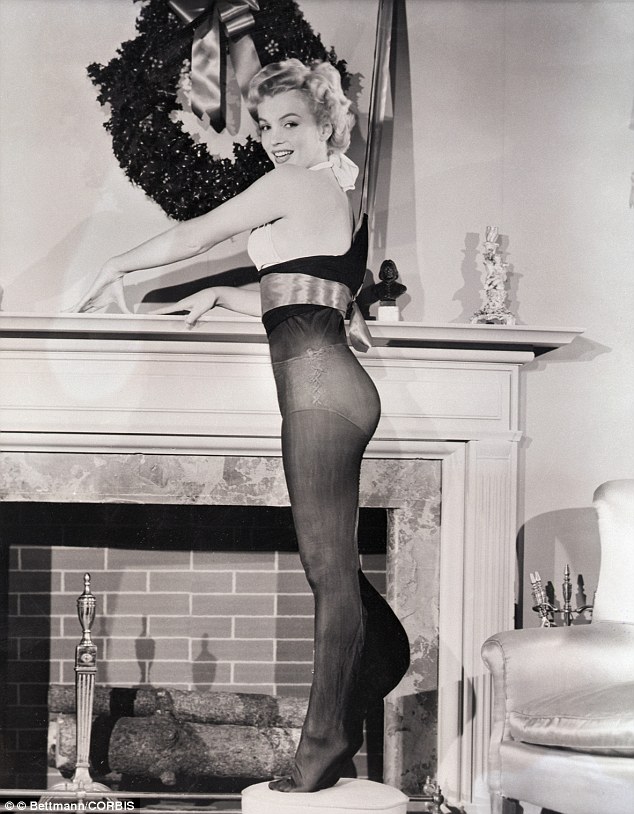
Merry Christmas from Marilyn Monroe, 1951
Necessity being the mother of invention, we are surmounting the problem of an overabundance of riches in Christmas content as published over the years in TheBluegrassSpecial.com and in Deep Roots by offering seasonal travelers this Yuletide Baedeker, a guide to favorite features from Christmas issues past (dating to our launch year of 2008), all linked for easy access. As always, our picks of the year’s finest new holiday albums will join the Baedeker, including our picks from the years 2017-2019 that were published as reviews in Deep Roots in the Baedeker’s absence. In addition to these new reviews, we offer what we believe to be the single largest archive of Yuletide album reviews, broken down into the current Picks, Essentials and Gathering Evergreens (a smidgen below Essential but eminently worthy of inclusion in any serious holiday music collection—our judgment call).
Not content to stop at album reviews, the Baedeker includes the real-life stories that inspired some of most beloved carols and songs; reviews of holiday DVDs; a guide to the best in animated Christmas features; Christmas fiction by Leo Tolstoy and Hans Christian Anderson; essays such as Charles Dickens’s “What Christmas Means As We Grow Older,” and the story of how in 1887 a young girl’s letter wondering if Santa Claus exists was answered in what has become, Yes, Virginia, arguably the most famous newspaper editorial in history; great poetry inspired by the holiday season; a best-selling author’s reflections on creating new Hannukah traditions she hopes her own children will pass on to their children; and gospel editor Bob Marovich’s history of gospel music’s response to the Christmas season.
The “stocking stuffers” here, if you will, range from the tender Christmas Eve monologue proffered by The Honeymooners’ Ralph Kramden; Louis Armstrong’s priceless reading of “The Night Before Christmas”; a great scene from the 1984 film version of A Christmas Carol between Marley’s Ghost (Ralph Finlay in a star turn) and Ebenezer Scrooge (George C. Scott); and Maya Angelou’s enduring contribution to the season, “Amazing Peace—A Christmas Poem.” We believe these chestnuts capture fundamental truths about the season’s true spirit. As does, most certainly, a fetching Marilyn Monroe Christmas wish designed to heat up a cold winter night (look up!).
New to this year’s Baedeker: The stories of, respectively, the very first Christmas stamps—yes, stamps, as on letters and cards of yore—issued in the world (the first being a distinction held by Canada) and in the U.S.; and of the first self-adhesive stamp, which happened to be a Christmas 1974 issue by the USPS featuring an illustration of the weathervane from George Washington’s Mount Vernon home. Self-adhesives had a rather tortured history—and in fact went out of print for 15 years until the USPS issued the 29-cent Eagle and Shield stamps in 1992. Thanks to our friends at the legendary Mystic Stamp Company in Connecticut, we offer the true stories of the genesis and evolution of Christmas stamps from 1889 to the present. It’s another worldwide exclusive by Deep Roots!
Also, we’re continuing to retrieve and revise Christmas content from our original incarnation as TheBluegrassSpecial.com. This year’s motherlode of reincarnated Yuletide fare includes: reviews of Brian Setzer’s Christmas albums, always must listening at this time of year; the origin story of “Do You Hear What I Hear,” a song inspired by fears of a nuclear holocaust; reviews of Enya’s And Winter Came, Nancy Lamott’s beautiful Just in Time for Christmas, The Persuasions’ essential You’re All I Want for Christmas, Tony Bennett’s one-two knockout punch of Snowfall and The Classic Christmas Album, and we’ve combined three reviews into one appraisal of the magnificent Wonderland series of Christmas anthologies featuring evergreen tracks by artists well known and obscure from the ‘40s to the present day. Herein you will find as well revised versions of the origin stories of “Hark! The Herald Angels Sing” and “Angels We Have Heard on High’; updated reviews of classic Christmas cartoons in From the inkwell; and a revised account of how Rudolph the Red-Nosed Reindeer went down in history—and how!
The feature we’re most proud of immediately follows this introduction: Our Christmas Best to You. Its source is a holiday greeting, circa late ‘80s, sent to members of the press only, by Bonneville Media Communications out of Salt Lake City, Utah. It came in the form of a 28-minute cassette tape documenting the efforts of a male caller phoning around in an effort to collect—for his “true love”—all the items enumerated in the song “The 12 Days of Christmas.” We’ve done our research and checked it twice, three times, in an effort to confirm the identities of the dramatis personae starring on the tape and pieced together the most complete account of who’s who and what’s what with respect to this unique offering that is otherwise lost to history. It’s also quite likely Deep Roots is the only place in the cotton-pickin’ world where you can hear “Our Christmas Best to You.”
Without further ado…on Dancer, on Prancer…!
OUR CHRISTMAS BEST TO YOU
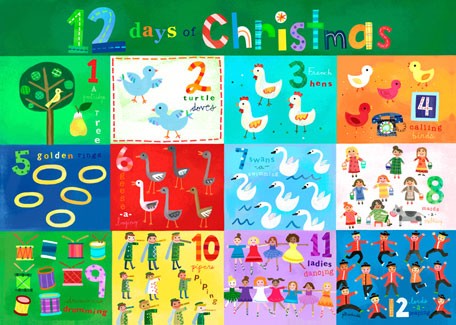
In the late ‘80s the Salt Lake City, Utah, firm then called Bonneville Media Communications sent out a holiday greeting to members of the press only. It was a cassette tape, some 28 minutes in length, titled OUR CHRISTMAS BEST TO YOU. On it an actor named Don Richmond (or Richman) calls around trying to gather up, for his “true love,” all the presents mentioned in the song “The 12 Days of Christmas.” The results of those calls are quite amusing, sometimes laugh-out-loud hilarious, but never insulting or profane—this isn’t Jerky Boys material. The good humor of (most of) those on the receiving end of the calls is a big part of why Richmond’s quest is so entertaining. That the tape is so heartwarming, however, has much to do with the interspersed interviews with a charming group of young tykes (whose descriptions of Santa Claus’s appearance is one of many sweet moments made all the more memorable by being so disarming) and notably with department store Santa Tony Zucca, who tells a poignant anecdote about a visit from sad child, whose despair was rooted in a recent tragedy. Taken aback, Zucca quickly regrouped and, in a flash of inspiration, offered the lad a bit of wisdom for the ages. The humility in Zucca’s retelling never fails to choke us up, all these years and innumerable playbacks later. Follow this link to Our Christmas Best to You.
SING WE NOW OF CHRISTMAS 2022

You know somethin’, sweetheart? Christmas is, well, it’s about the best time of the whole year. You walk down the streets, even for weeks before Christmas comes, and there’s lights hanging up, green ones, and red ones, sometimes there’s snow. And everybody’s hustling some place. But they don’t hustle around Christmas time like they usually do. Y’know, they’re a little more friendlier; they bump into you, they laugh and say ‘Pardon me’ and ‘Merry Christmas.’ Especially when it gets real close to Christmas night. Everybody’s walkin’ home, you can hardly hear a sound. Bells are ringin’, kids are singin’, snow is comin’ down. And boy what a pleasure it is to think that you got some place to go to, and the place that you’re going to has somebody in it that you really love…someone you’re nuts about. Merry Christmas.’
(Ralph Kramden reflecting on the Yuletide, from The Honeymooners’ Christmas episode, ‘‘Twas The Night Before Christmas,’’ December 24, 1955)


‘Oh! captive, bound, and double-ironed,’ cried the phantom, ‘not to know, that ages of incessant labour by immortal creatures, for this earth must pass into eternity before the good of which it is susceptible is all developed! Not to know that any Christian spirit working kindly in its little sphere, whatever it may be, will find its mortal life too short for its vast means of usefulness! Not to know that no space of regret can make amends for one life’s opportunity misused! Yet such was I! Oh! such was I!’
‘But you were always a good man of business, Jacob,’ faltered Scrooge, who now began to apply this to himself.
‘Business!’ cried the Ghost, wringing its hands again. ‘Mankind was my business. The common welfare was my business; charity, mercy, forbearance, and benevolence, were, all, my business. The dealings of my trade were but a drop of water in the comprehensive ocean of my business!’
(Charles Dickens, ‘A Christmas Carol,’ published on December 19, 1843; the above video clip is from the 1984 made-for-television adaptation directed by Clive Donner and starring George C. Scott as Ebenezer Scrooge. Frank Finlay has a star turn as Marley’s ghost offering his old partner one last chance at redemption.)

LOUIS ARMSTRONG reads ‘THE NIGHT BEFORE CHRISTMAS’

At his home in Astoria, Queens, New York on February 26, 1971, Louis Armstrong made what proved to be his final recording, a recitation of Clement Moore’s classic poem ‘The Night Before Christmas,’ later issued as a single by the Lorillard Tobacco Company. Two weeks following this session he suffered a heart attack and was in intensive care until May 5, when he insisted on going home. On July 5 he announced he was ready to perform again and requested his band convene for rehearsal. He passed away at 5:30 the next morning, July 6, 1971. This clip also includes the single’s B side, a raucous live version of “When the Saints Go Marching In” with Pops blowing a frantic horn and strutting through the lyrics as only this master interpreter could.

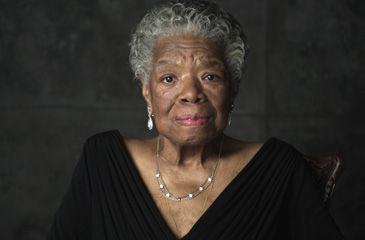
AMAZING PEACE–A CHRISTMAS POEM
Read by the poet at the lighting of the National Christmas Tree at the White House on December 1, 2005, Maya Angelou’s celebration of the ‘Glad Season’ is at once a radiant affirmation of the goodness of life and a beautiful holiday gift for people of all faiths. Beautiful and moving, Ms. Angelou’s words inspire us to embrace the peace and promise of Christmas, so that hope and love may once again light up our holidays and the world.
Two Seasonal Classics from O. Henry
‘The Gift of the Magi’
‘One dollar and eighty-seven cents. … And the next day would be Christmas.’

‘The Gift of the Magi,’ from O. Henry’s Full House (1952), starring Farley Granger and Jeanne Crain, directed by Henry King from a screenplay by Walter Bullock. Film introduced by John Steinbeck. On Christmas Eve, with little money, Della sells her hair to buy her husband Jim a watch fob. Jim has sold his watch to buy her a pair of ornamental combs. When they exchange these now useless gifts, they realize how deep is their love for one another. YouTube commenter Ehsaas Mehta observed: “This is the only story which reflects the meaning of love. It really reminded me of how we all have lost the true meaning of love.This story shall always remind us of how love is based on sacrifice.’
‘The Cop and The Anthem’
‘Come home, O sinner, come home…’

‘The Cop and The Anthem,’ from O. Henry’s Full. House (1952), directed by Henry Koster from a screenplay by Lamar Trotti, starring Charles Laughton, Marilyn Monroe and David Wayne. As winter approaches, a vagrant decides it’s time for his annual winter spell in prison. But no matter how many petty crimes he indulges in–including eating in an expensive restaurant when flat broke, only to be literally tossed out rather than arrested–he fails to get himself hauled off to the comforts of a prison cell. One of his escapades was to accost a young lady window-shopping in the hope she’d report his advances to a policeman glowering nearby. Instead she turned out to be a hooker, played in a one-minute role by a rising young star named Marilyn Monroe. Laughton’s fellow tramp in this beautiful blend of comedy and pathos is played by David Wayne. As for Laughton, he gives a towering performance culminating in his character being transformed by a visit to a church service (where the unseen choir is singing the hymn of invitation, “Softy and Tenderly,” written by Will L. Thompson in 1880) and deciding to change his ways and make something of himself. In true O. Henry style, it doesn’t quite work out as planned.

CHRISTMAS PICKS, 2021

FOOLS FOR THE YULE, Uptown Vocal Jazz Quartet (HouseKat Records)— Building acclaim whenever and wherever it appears, the Uptown Vocal Jazz Quartet will surely add some more 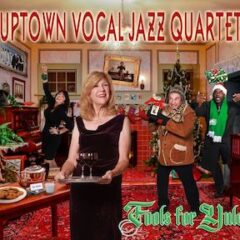 rave reviews to its clippings with its first holiday effort, Fools for Yule, on which the quartet’s strengths are in full flower. The result is a seasonal album worthy of regular rotation in any Yuletide fan’s collection. That the mood is easygoing throughout is indicative of the group’s command of tone and texture in being easy on the ears but also challenging on its own terms without diminishing the warm, cozy mood sustained throughout. … The most surprising wrinkle in the proceedings is tender, tightly harmonized rendition of “Silent Night” lent added beauty by an evocative solo break courtesy special guest Keith Carr on Irish bouzouki—a moment so totally unexpected but so rich in atmosphere as to set this version apart from all the standard renditions you’ve heard. Read the full review here.
rave reviews to its clippings with its first holiday effort, Fools for Yule, on which the quartet’s strengths are in full flower. The result is a seasonal album worthy of regular rotation in any Yuletide fan’s collection. That the mood is easygoing throughout is indicative of the group’s command of tone and texture in being easy on the ears but also challenging on its own terms without diminishing the warm, cozy mood sustained throughout. … The most surprising wrinkle in the proceedings is tender, tightly harmonized rendition of “Silent Night” lent added beauty by an evocative solo break courtesy special guest Keith Carr on Irish bouzouki—a moment so totally unexpected but so rich in atmosphere as to set this version apart from all the standard renditions you’ve heard. Read the full review here.
A GREAT MIRACLE, Jeremiah Lockwood’s Guitar Soli Chanukah Record (Reboot Records)—In a Deep Roots exclusive, Jeremiah Lockwood shares the 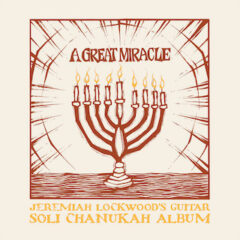 backstory of his John Fahey-inspired solo acoustic Guitar Soli Chanukah Record. Writes Lockwood: I have made this record, as an aspiration to feel steady and warm and protected in memories and love… and maybe also to imagine those intimate sounds of the Chanukah ritual taking their place in the space where Christmas carols usually prevail…we need all kinds of strength and I have an idea about where I’m going to find it, and I would like to share that with you. Also: An illuminating interview with the artist by David Wilensky in J: The Jewish News of Northern California, reprinted here with permission. Read Jeremiah’s essay here.
backstory of his John Fahey-inspired solo acoustic Guitar Soli Chanukah Record. Writes Lockwood: I have made this record, as an aspiration to feel steady and warm and protected in memories and love… and maybe also to imagine those intimate sounds of the Chanukah ritual taking their place in the space where Christmas carols usually prevail…we need all kinds of strength and I have an idea about where I’m going to find it, and I would like to share that with you. Also: An illuminating interview with the artist by David Wilensky in J: The Jewish News of Northern California, reprinted here with permission. Read Jeremiah’s essay here.
CHANTS DE NOËL DU MONDE, Arsys Bourgogne, Pierre Cao, Conductor (Naïve) (2012 release)— From time to time a recording comes along that emphasizes the international 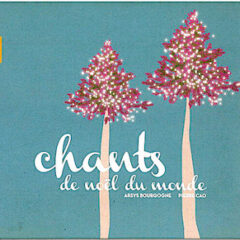 character of much Christmas music. The French choir Arsys Bourgogne, which, since assembling in 1999, has made quite a name for itself spanning the globe in its programming. Conducted by the Luxembourg native Pierre Cao, the 32-member ensemble emerges in both holiday and international mode on Chants de Noël du Monde with a collection of sacred and secular Christmas music spanning six centuries and sung in French, English, German, Italian, Spanish, Portuguese and Latin, all performed a cappella. The 23 tracks include familiar carols like “O Little Town Of Bethlehem,” “In Dulci Jubilo” and “Silent Night” (sung in English, French and German), as well as the spiritual “Go, Tell It On The Mountain” with a richly textured arrangement courtesy Scott Warren. There are also secular standards, from the spirited opening “We Wish You a Merry Christmas” to a truly majestic “White Christmas,” the latter capturing a wealth of emotions from poignant to heartwarming. Read the full review here.
character of much Christmas music. The French choir Arsys Bourgogne, which, since assembling in 1999, has made quite a name for itself spanning the globe in its programming. Conducted by the Luxembourg native Pierre Cao, the 32-member ensemble emerges in both holiday and international mode on Chants de Noël du Monde with a collection of sacred and secular Christmas music spanning six centuries and sung in French, English, German, Italian, Spanish, Portuguese and Latin, all performed a cappella. The 23 tracks include familiar carols like “O Little Town Of Bethlehem,” “In Dulci Jubilo” and “Silent Night” (sung in English, French and German), as well as the spiritual “Go, Tell It On The Mountain” with a richly textured arrangement courtesy Scott Warren. There are also secular standards, from the spirited opening “We Wish You a Merry Christmas” to a truly majestic “White Christmas,” the latter capturing a wealth of emotions from poignant to heartwarming. Read the full review here.
HOLIDAY MUSIC STOCKING STUFFERS, 2021—A tasty trio of holiday tunes released exclusively for the season. First up: “My Gingerbreak Man” by THE TWANGTOWN PARAMOURS (Mike T. Lewis and MaryBeth Zamer), who will get 2022 off to a fast start with a long-awaited and quite wonderful new album, Double Down on a Bad Thing,” described by Lewis as “a distinct departure from anything else we’ve done and by far my favorite project.” “My. Gingerbreak Man” is a swinging, sultry number that embraces the retro feel of the forthcoming album even as it captures a playful aspect of seasonal music, while allowing Ms. Zamer to show off some of the best pipes and interpretive singing chops extant. Next: “Solstice with the Mostest,” a delightful seasonal blowout courtesy the fun loving NINETEEN HAND HORSE, who ask: “Who needs another holiday song when you can have yourself a SOLSTICE with the MOSTEST, my dear, to fill you with joy, peace, love, and oh, yeah, the last couple of crazy years?” And certainly not least of all: TAYLOR RAE with a lovely vocal-and-guitar rendition of “Have Yourself a Merry Little Christmas,” which serves as the gifted twenty-something artist’s musical Christmas card for 2021 following in the wake of her acclaimed album, Mad Twenties. Join the party here.
HOME FOR CHRISTMAS WITH JAN DALEY, Jan Daley (Log Records)— If you’re going to title an album At Home With…, then you ought to make certain the music it presents exudes the  warmth and intimacy you would expect of an artist working at home, even when you know the project was recorded in a real, fully outfitted professional facility that may be comfortable but face it, there’s no place like home. Which is a long way of saying Jan Daley went into Entourage studio in North Hollywood and made it feel like home in leading a tight, empathetic small combo through a baker’s dozen of familiar sacred and secular carols and songs that include her own “Can’t Give You Any Answers” and a wonderful Streisand-penned love letter to a newborn baby, “The Best Gift,” wherein Ms. Daley’s husky timbre sounds at time uncannily like that of Babs herself. The homespun feeling arises first and foremost in the comfort level Ms. Daley exudes—she’s making no demands of the songs but only of herself, to be a worthy messenger for their narratives. Not only is her stance straightforwardly sincere, it’s limned by a sense of awe and reverence for the season. No songs are tossed off or treated in a flighty manner—you sense she genuinely loves the season and the gifts it brings. Not physical gifts, mind you, but gifts that ennoble the spirit, speak of nature’s wonders and celebrate friends and family, evidenced at the album’s start when she opens with “I’ll Be Home for Christmas” but tellingly adds the seldom heard verse before gliding into the familiar hopeful lyric and is bathed in strings. Read the full review her
warmth and intimacy you would expect of an artist working at home, even when you know the project was recorded in a real, fully outfitted professional facility that may be comfortable but face it, there’s no place like home. Which is a long way of saying Jan Daley went into Entourage studio in North Hollywood and made it feel like home in leading a tight, empathetic small combo through a baker’s dozen of familiar sacred and secular carols and songs that include her own “Can’t Give You Any Answers” and a wonderful Streisand-penned love letter to a newborn baby, “The Best Gift,” wherein Ms. Daley’s husky timbre sounds at time uncannily like that of Babs herself. The homespun feeling arises first and foremost in the comfort level Ms. Daley exudes—she’s making no demands of the songs but only of herself, to be a worthy messenger for their narratives. Not only is her stance straightforwardly sincere, it’s limned by a sense of awe and reverence for the season. No songs are tossed off or treated in a flighty manner—you sense she genuinely loves the season and the gifts it brings. Not physical gifts, mind you, but gifts that ennoble the spirit, speak of nature’s wonders and celebrate friends and family, evidenced at the album’s start when she opens with “I’ll Be Home for Christmas” but tellingly adds the seldom heard verse before gliding into the familiar hopeful lyric and is bathed in strings. Read the full review her
OLD CHRISTMAS RETURN’D, The York Waits, withRobin Jeffrey (lute, guitar, cittern, theorbo) and Richard Wistreich (vocals) (Saydisc, 1992)— Subtitled “Christmas music 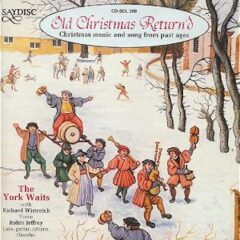 and songs from past ages,” this scintillating 1992 release from the York Waits (a septet based in the walled city of York in northeast England; the band’s name is taken from the York city band of the 14th century), is a mixture of Christmas music and carols from primarily the sixteenth and seventeenth centuries, including seasonal-themed instrumental interludes. Composers such as Michael Praetorius, Thomas Ravenscroft, Josef Obrecht and Anthony Holborne are among the early music stars, if you will, represented in the program. The York Waits (present lineup: Antony Barton, Tim Bayley, Lizzie Gutteridge, Anna Marshal, Susan Marshall and William Marshall) are here joined by Robin Jeffrey and the robust-voiced vocalist Richard Wistreich, who has a number of memorable star turns. He opens the album in stentorian fashion with a severe “Gabriel from Heven-King,” the anonymous, oft-recordred 13th century sacred song given moving heft by the vocalist’s authoritative reading backed by delicate pipe and lute flourishes. He’s equally affecting when toning down his delivery to better frame the shifting seasonal images described in another familiar gem, the 17th century English ballad “Drive the cold winter away,” variously also known as “All Hail to the Days,” “In Praise of Christmas” and “The Praise of Christmas.” Read the full review here
and songs from past ages,” this scintillating 1992 release from the York Waits (a septet based in the walled city of York in northeast England; the band’s name is taken from the York city band of the 14th century), is a mixture of Christmas music and carols from primarily the sixteenth and seventeenth centuries, including seasonal-themed instrumental interludes. Composers such as Michael Praetorius, Thomas Ravenscroft, Josef Obrecht and Anthony Holborne are among the early music stars, if you will, represented in the program. The York Waits (present lineup: Antony Barton, Tim Bayley, Lizzie Gutteridge, Anna Marshal, Susan Marshall and William Marshall) are here joined by Robin Jeffrey and the robust-voiced vocalist Richard Wistreich, who has a number of memorable star turns. He opens the album in stentorian fashion with a severe “Gabriel from Heven-King,” the anonymous, oft-recordred 13th century sacred song given moving heft by the vocalist’s authoritative reading backed by delicate pipe and lute flourishes. He’s equally affecting when toning down his delivery to better frame the shifting seasonal images described in another familiar gem, the 17th century English ballad “Drive the cold winter away,” variously also known as “All Hail to the Days,” “In Praise of Christmas” and “The Praise of Christmas.” Read the full review here
STRICTLY COOLSVILLE—Revised and updated (2021) reviews of a trio of scintillating holiday anthologies released in 2003 on the Shout Factory/Astrolux label all 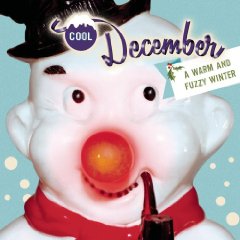 under the Wonderland rubric. These timeless contributions to seasonal music include: Wonderland: Yulesville—The Other Tinseltown (tunes by Leon Redbone, Julie London, Ann-Margret with Al Hirt, Duke Ellington, Claudine Longet, Louis Prima, Booker T. & the MG’s, Tiny Tim, Sergio Mendes & Brasil ’66, Marlowe Morris; Lionel Hampton, Four Piece Suit, the Randy Van Horne Singer and Holly Cole; Wonderland: Under the. Mistletoe—Reindeer & Romance (Lou Rawls, Dinah Washington, Rosemary Clooney, Ella Fitzgerald, Peggy Lee, Bobby Darin, Aretha Franklin, Sarah Vaughan, Ann Hampton Calloway, John Pizzarelli, Kevin Mahogany; Steve Tyrell); and Wonderland: Cool December—A Warm and Fuzzy Winter (Bing Crosby, Dean Martin, John Pizzarelli, Frankie Carle, Marjorie Hughes, Doris Day, Pearl Bailey Hot Lips Page, Jo Stafford, Billie Holiday, Ella Fitzgerald, Stacey Kent, René Marie). Seriously, there is not a bad cut to be found on these discs, and in terms of capturing the many moods of the Yule season, this collection simply cannot be beat. Originally published in TheBluegrassSpecial.com as individual reviews, this 2021 revision consolidates, updates and expands the three reviews, while also featuring six videos of tunes from the titles in question. Read the full review here.
under the Wonderland rubric. These timeless contributions to seasonal music include: Wonderland: Yulesville—The Other Tinseltown (tunes by Leon Redbone, Julie London, Ann-Margret with Al Hirt, Duke Ellington, Claudine Longet, Louis Prima, Booker T. & the MG’s, Tiny Tim, Sergio Mendes & Brasil ’66, Marlowe Morris; Lionel Hampton, Four Piece Suit, the Randy Van Horne Singer and Holly Cole; Wonderland: Under the. Mistletoe—Reindeer & Romance (Lou Rawls, Dinah Washington, Rosemary Clooney, Ella Fitzgerald, Peggy Lee, Bobby Darin, Aretha Franklin, Sarah Vaughan, Ann Hampton Calloway, John Pizzarelli, Kevin Mahogany; Steve Tyrell); and Wonderland: Cool December—A Warm and Fuzzy Winter (Bing Crosby, Dean Martin, John Pizzarelli, Frankie Carle, Marjorie Hughes, Doris Day, Pearl Bailey Hot Lips Page, Jo Stafford, Billie Holiday, Ella Fitzgerald, Stacey Kent, René Marie). Seriously, there is not a bad cut to be found on these discs, and in terms of capturing the many moods of the Yule season, this collection simply cannot be beat. Originally published in TheBluegrassSpecial.com as individual reviews, this 2021 revision consolidates, updates and expands the three reviews, while also featuring six videos of tunes from the titles in question. Read the full review here.
‘ZAT YOU, SANTA CLAUS? BRIAN SETZER PUTS HIS CAT CLOTHES ON AND ROCK THE YULE, AGAIN—Revised and updated reviews of the Brian Setzer Orchestra’s Dig That Crazy Christmas (2005) and Ultimate Christmas Collection (2009) on Surfdog Records. In a worthy followup to his 2002 Yuletide fest, Boogie Woogie Christmas, Brian Setzer and his Orchestra returned in 2005 for a  wild-eyed holiday treat via Dig That Crazy Christmas. The whole troupe roars and swings through 11 evergreens, so to speak, and Setzer contributes two new originals: a horn-driven stomper titled “Hey Santa!” spiced with some sizzling vocal and instrumental interplay between Setzer and the orchestra; and a roaring blues grinder in “Santa Drives a Hot Rod,” complete with blaring horns and a fine, growling vocal from Setzer describing the wonders of Santa’s new souped-up wheels now supplanting his a “rusty old sleigh.” Christmas 2009 brought another Setzer Yuletide blast in Ultimate Christmas Collection, a compilation boasting some of the swingin’est tunes from the 2002 and 2005 holiday long players in a collection further sweetened by a DVD, Christmas Extravaganza, featuring no less than 25 songs from a near-two-hour performance. Some of the favorites from the earlier album include the ambitious “Nutcracker Suite,” with its powerhouse horn chart, impressive melding of jazz and classical sensibilities and faithfulness to the moods and spirits of Tchaikovsky’s original composition (and which prefigured by five years Setzer’s album-length journey into swinging the classics, Wolfgang’s Big Night Out); the blazing, Eddie Cochran-influenced romp through “Jingle Bells,” featuring Setzer in a bravura, swaggering performance, punctuating his soloing with some clever textural shadings—courtesy searing, distorted chordings; thick, single-string soloing; and cool filigrees such as a variation on the swooping, descending “Pipeline” run; and not least of all, a deliciously suggestive duet with none other than Ann-Margret, in very fine, sex-kitten voice, on “Baby It’s Cold Outside,” with Setzer playing her male foil to charming perfection and adding a splendid, robust guitar solo to boot. Read the full rockin’ review here.
wild-eyed holiday treat via Dig That Crazy Christmas. The whole troupe roars and swings through 11 evergreens, so to speak, and Setzer contributes two new originals: a horn-driven stomper titled “Hey Santa!” spiced with some sizzling vocal and instrumental interplay between Setzer and the orchestra; and a roaring blues grinder in “Santa Drives a Hot Rod,” complete with blaring horns and a fine, growling vocal from Setzer describing the wonders of Santa’s new souped-up wheels now supplanting his a “rusty old sleigh.” Christmas 2009 brought another Setzer Yuletide blast in Ultimate Christmas Collection, a compilation boasting some of the swingin’est tunes from the 2002 and 2005 holiday long players in a collection further sweetened by a DVD, Christmas Extravaganza, featuring no less than 25 songs from a near-two-hour performance. Some of the favorites from the earlier album include the ambitious “Nutcracker Suite,” with its powerhouse horn chart, impressive melding of jazz and classical sensibilities and faithfulness to the moods and spirits of Tchaikovsky’s original composition (and which prefigured by five years Setzer’s album-length journey into swinging the classics, Wolfgang’s Big Night Out); the blazing, Eddie Cochran-influenced romp through “Jingle Bells,” featuring Setzer in a bravura, swaggering performance, punctuating his soloing with some clever textural shadings—courtesy searing, distorted chordings; thick, single-string soloing; and cool filigrees such as a variation on the swooping, descending “Pipeline” run; and not least of all, a deliciously suggestive duet with none other than Ann-Margret, in very fine, sex-kitten voice, on “Baby It’s Cold Outside,” with Setzer playing her male foil to charming perfection and adding a splendid, robust guitar solo to boot. Read the full rockin’ review here.
AND WINTER CAME…
Enya
(Warner Reprise Records, 2008; revised and expanded, 2021)— Angels take wing in “Journey of the Angels.” Holly and mistletoe lend festive colors to “White Is In the Winter Night.” A bright 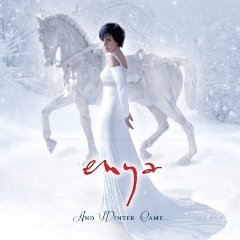 new star lights up the night in “Dreams Are More Precious.” Lovers nestle closely enough to hear other’s heartbeats on a snowy night in “Stars and Midnight Blue.” In the bleak midwinter, the spirit of Christmas is something more pervasive than a single day on the calendar. Irish enchantress Enya has offered not a Christmas album, but rather an album-length meditation on the Yuletide season, its sound, its totems, its joys, its summons to reflection and introspection. Two specifically Christmas songs are a sort of binding thread—a sublime, stately and searching version of “O Come, O Come, Emmanuel” and, 20 years after she first recorded it, “Silent Night,” sung in her native Gaeilge language and rendered as a stately, calming prayer at journey’s close—but otherwise this outing depicts Enya in a kind of winter wonderland viewed from her mind’s eye. And Winter Came… is one for this season, and for many seasons to come. Read the full review here.
new star lights up the night in “Dreams Are More Precious.” Lovers nestle closely enough to hear other’s heartbeats on a snowy night in “Stars and Midnight Blue.” In the bleak midwinter, the spirit of Christmas is something more pervasive than a single day on the calendar. Irish enchantress Enya has offered not a Christmas album, but rather an album-length meditation on the Yuletide season, its sound, its totems, its joys, its summons to reflection and introspection. Two specifically Christmas songs are a sort of binding thread—a sublime, stately and searching version of “O Come, O Come, Emmanuel” and, 20 years after she first recorded it, “Silent Night,” sung in her native Gaeilge language and rendered as a stately, calming prayer at journey’s close—but otherwise this outing depicts Enya in a kind of winter wonderland viewed from her mind’s eye. And Winter Came… is one for this season, and for many seasons to come. Read the full review here.
MERLE HAGGGARD: Making a Stand for Things That Matter (2021 revision)–Originally issued on Capitol in 1973 as Merle Haggard’s Christmas Present: Something Old, Something New, Merle 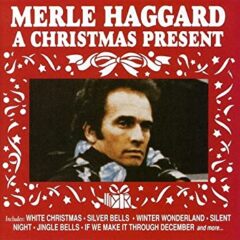 Haggard’s Christmas album (co-produced by Ken Nelson and Fuzzy Owen, Hag’s A team behind the board) has only 10 cuts, but all have a special feeling about them. The world of 1973 wasn’t in nearly as bad a shape as it is now when Hag penned his devastating chronicle of a family on the edge of financial collapse, “If We Make It Through December,” but if ever a sentiment was appropriate for December 2011, with unemployment seeming intractable, and the economy at home and even more so abroad still staggering, it is this. The song was chilling enough back then, but now it seems eerily, unfortunately prescient—Hag saw it all coming. Masterful in all respects, Hag’s Yuletide gift makes a stand for the things that matter. Follow this link to the full review.
Haggard’s Christmas album (co-produced by Ken Nelson and Fuzzy Owen, Hag’s A team behind the board) has only 10 cuts, but all have a special feeling about them. The world of 1973 wasn’t in nearly as bad a shape as it is now when Hag penned his devastating chronicle of a family on the edge of financial collapse, “If We Make It Through December,” but if ever a sentiment was appropriate for December 2011, with unemployment seeming intractable, and the economy at home and even more so abroad still staggering, it is this. The song was chilling enough back then, but now it seems eerily, unfortunately prescient—Hag saw it all coming. Masterful in all respects, Hag’s Yuletide gift makes a stand for the things that matter. Follow this link to the full review.
NANCY LAMOTT, Suffused With Beauty (2021 revision)–Nancy Lamott and beauty were on intimate terms. It radiated from her warm personality, resonated in her tender vocals, and suffused the 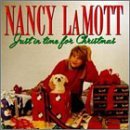 recordings she made before succumbing to cancer in 1995 at age 43. Disc jockey Jonathan Schwartz declared Lamott the finest cabaret singer since the Chairman of the Board, praise well earned by Lamott and thoughtfully dispensed by Schwartz. Like Sinatra, Lamott sought out literate songs with a folksy quality–the settings may have been urbane, but the feelings were universal. The Great American Songbook has rarely had so effective an advocate as Nancy Lamott. Her lone Christmas album, Just In Time for Christmas, is a crash course in all that was remarkable about this gifted artist.
recordings she made before succumbing to cancer in 1995 at age 43. Disc jockey Jonathan Schwartz declared Lamott the finest cabaret singer since the Chairman of the Board, praise well earned by Lamott and thoughtfully dispensed by Schwartz. Like Sinatra, Lamott sought out literate songs with a folksy quality–the settings may have been urbane, but the feelings were universal. The Great American Songbook has rarely had so effective an advocate as Nancy Lamott. Her lone Christmas album, Just In Time for Christmas, is a crash course in all that was remarkable about this gifted artist.
THE PERSUASIONS: IN ALL WEATHERS, GLAD TIDINGS (2021 revision)—Given how fundamental the church has been to just about everything the Persuasions have sung in their long career, it’s rather 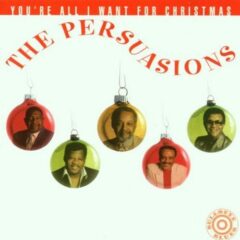 amazing that it took this incomparable a cappella quintet until 1997 to get around to a Christmas album. What’s important, though, is that they did get around to it, because it’s everything you would expect of a Persuasions Christmas album and more.because you never know for certain how the singers are going to find unique ways into their songs. In this case, most of the songs are so familiar as to be daunting, it would seem, to those attempting any variations on the themes. But the Persuasions are just not any group of a cappella practitioners, and so what they do with “Do You Hear What I Hear?” and “Silent Night,” to name a couple of prime examples, is not like anything you’ve heard anyone else do with those songs. Even so, it’s important to remember a fact borne out by the Persuasions’ history: they don’t try to make you forget the original, or most memorable, rendering of the songs they choose to investigate, but rather show you another side of those songs, a different perspective, so that their version enlarges the narrative, adding color, texture and even feelings that may be more subliminal or understated aspects of what you’re used to hearing.
amazing that it took this incomparable a cappella quintet until 1997 to get around to a Christmas album. What’s important, though, is that they did get around to it, because it’s everything you would expect of a Persuasions Christmas album and more.because you never know for certain how the singers are going to find unique ways into their songs. In this case, most of the songs are so familiar as to be daunting, it would seem, to those attempting any variations on the themes. But the Persuasions are just not any group of a cappella practitioners, and so what they do with “Do You Hear What I Hear?” and “Silent Night,” to name a couple of prime examples, is not like anything you’ve heard anyone else do with those songs. Even so, it’s important to remember a fact borne out by the Persuasions’ history: they don’t try to make you forget the original, or most memorable, rendering of the songs they choose to investigate, but rather show you another side of those songs, a different perspective, so that their version enlarges the narrative, adding color, texture and even feelings that may be more subliminal or understated aspects of what you’re used to hearing.
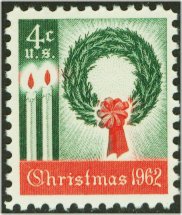 A tale in three parts: (1) How Canada came to be the first country to issue a Christmas stamp with its 1898 Queen Victoria-approved stamp honoring Christmas and the birth of Jesus Christ. This was also the first Canada stamp to feature multiple colors. (2) The First U.S. Christmas Stamp—issued on November 1, 1962, starting a tradition that continues to this day. The series is now known as Contemporary Christmas with image and topics relating to our modern Christmas celebrations. In recent years the themes have expanded with the introductions of stamps honoring Hanukkah, Kwanzaa, Eid and Diwali. (3) The 1975 Contemporary Christmas stamp featuring the image from an 1878 Christmas card, one of the earliest Christmas cards printed in the U.S.
A tale in three parts: (1) How Canada came to be the first country to issue a Christmas stamp with its 1898 Queen Victoria-approved stamp honoring Christmas and the birth of Jesus Christ. This was also the first Canada stamp to feature multiple colors. (2) The First U.S. Christmas Stamp—issued on November 1, 1962, starting a tradition that continues to this day. The series is now known as Contemporary Christmas with image and topics relating to our modern Christmas celebrations. In recent years the themes have expanded with the introductions of stamps honoring Hanukkah, Kwanzaa, Eid and Diwali. (3) The 1975 Contemporary Christmas stamp featuring the image from an 1878 Christmas card, one of the earliest Christmas cards printed in the U.S.
CHRISTMAS 1974: SANTA (USPS) BRINGS THE 1ST SELF-ADHESIVE STAMP
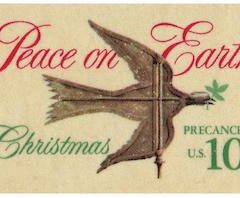 Issued November 15, 1974, the first self-adhesive stamp in U.S. history carried an illustration of the weathervane from George Washington’s Mount Vernon home. It was considered an experiment at the time, and a failed one at that owing to flaws in the rubber-based adhesive used at that time. Using an acrylic-based adhesive, the USPS issued a new batch of self-adhesives on November 19, 1989 but public reaction was thumbs down. Undeterred, the Post Office tried again in 1990 and two years later issued the first nationally distributed self-adhesives since 1974. By 2002 almost all U.S. stamps were self-adhesive.
Issued November 15, 1974, the first self-adhesive stamp in U.S. history carried an illustration of the weathervane from George Washington’s Mount Vernon home. It was considered an experiment at the time, and a failed one at that owing to flaws in the rubber-based adhesive used at that time. Using an acrylic-based adhesive, the USPS issued a new batch of self-adhesives on November 19, 1989 but public reaction was thumbs down. Undeterred, the Post Office tried again in 1990 and two years later issued the first nationally distributed self-adhesives since 1974. By 2002 almost all U.S. stamps were self-adhesive.

The 2020 Christmas Picks
ROBERT HUGILL’S CLASSICAL CHRISTMAS EVERGREENS
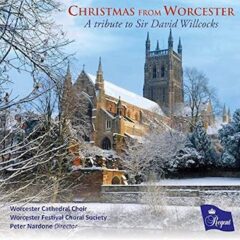 For this holiday season of the pandemic year 2020, we’ve assembled what might otherwise be headlined “Robert Hugill’s Holiday Hits.” Herein you’ll find a potpourri of Classical Christmas albums recommended by our Classical editor, Robert Hugill (a composer himself), in Deep Roots ranging from 2013 up to the present day. Although these albums are timeless, rendering their year of release irrelevant, it never hurts to be reminded of the bounty Mr. Hugill (who is best known—apart from his own work as a composer–for his acclaimed Classical website Planet Hugill–has discovered over time—including the King’s Singers’ instant classic, “Frosty Vs. Rudolph, The Re-Boot,” featured on the group’s Christmas Songbook album from 2016. Among the selections we’ve chosen from Planet Hugill’s annual Christmas CD roundups you’ll find several outstanding choral performances (Christmas With St. John’s, Christmas at Selwyn, Christmas from Worcester, all with abundant salutes to Sir David Willocks) along with other perspectives offered by the likes of the female vocal groups Papagena and the Juice Vocal Ensemble; a trip back to the Medieval carol heritage in The Secret Life of Carols: 800 Years of Christmas Music by The Telling, a female vocal and instrumental trio; A Spanish Nativity by stile antico; and the Georgian male voice choir Rustavi Choir along with the Mdzlevari Boys’ Choir performing composer-conductor Vakhtang Kakhidze‘s Christmas Trilogy with the Tbilisi Symphony Orchestra. Herein experience and enjoy a terrific mix of reverence, history and playfulness in the Christmas outpourings from around the globe and across the centuries. Buon Natale!
For this holiday season of the pandemic year 2020, we’ve assembled what might otherwise be headlined “Robert Hugill’s Holiday Hits.” Herein you’ll find a potpourri of Classical Christmas albums recommended by our Classical editor, Robert Hugill (a composer himself), in Deep Roots ranging from 2013 up to the present day. Although these albums are timeless, rendering their year of release irrelevant, it never hurts to be reminded of the bounty Mr. Hugill (who is best known—apart from his own work as a composer–for his acclaimed Classical website Planet Hugill–has discovered over time—including the King’s Singers’ instant classic, “Frosty Vs. Rudolph, The Re-Boot,” featured on the group’s Christmas Songbook album from 2016. Among the selections we’ve chosen from Planet Hugill’s annual Christmas CD roundups you’ll find several outstanding choral performances (Christmas With St. John’s, Christmas at Selwyn, Christmas from Worcester, all with abundant salutes to Sir David Willocks) along with other perspectives offered by the likes of the female vocal groups Papagena and the Juice Vocal Ensemble; a trip back to the Medieval carol heritage in The Secret Life of Carols: 800 Years of Christmas Music by The Telling, a female vocal and instrumental trio; A Spanish Nativity by stile antico; and the Georgian male voice choir Rustavi Choir along with the Mdzlevari Boys’ Choir performing composer-conductor Vakhtang Kakhidze‘s Christmas Trilogy with the Tbilisi Symphony Orchestra. Herein experience and enjoy a terrific mix of reverence, history and playfulness in the Christmas outpourings from around the globe and across the centuries. Buon Natale!
A BLUER SHADE OF CHRISTMAS (BLUES, BLUES CHRISTMAS, VOLS. 1-3 + DEATH MIGHT BE YOUR SANTA CLAUS, 2005-2013)— If you just want to go in far enough to 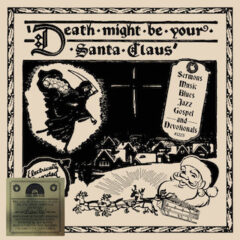 say you’ve been there, Death Might Be Your Santa Claus is the winning ticket, albeit one with a narrow focus. For a more thorough immersion in seasonal fare of varying stripes—reverent, cynical, despairing, jubilant, uplifting and naughty-but-nice—from across the roots spectrum (many of them scintillating rarities that otherwise might have been lost to history), Document’s three Blues, Blues Christmas releases simply can’t be beat. These are as essential as Christmas music gets. Volumes 1 and 2 were released in 2005 and 2008, respectively, and lo and behold the U.K.-based label has presented us with a third entry in the series in 2013, and it is simply spectacular.
say you’ve been there, Death Might Be Your Santa Claus is the winning ticket, albeit one with a narrow focus. For a more thorough immersion in seasonal fare of varying stripes—reverent, cynical, despairing, jubilant, uplifting and naughty-but-nice—from across the roots spectrum (many of them scintillating rarities that otherwise might have been lost to history), Document’s three Blues, Blues Christmas releases simply can’t be beat. These are as essential as Christmas music gets. Volumes 1 and 2 were released in 2005 and 2008, respectively, and lo and behold the U.K.-based label has presented us with a third entry in the series in 2013, and it is simply spectacular.
THAT TIME OF YEAR, Kristin Korb (Storyville Records) & CHRISTMAS MORNING, Silent Winters (Fallen Tree Records) (2019 releases)– A couple of nice, tradition-oriented Yuletide albums are in the offing from artists beyond these shores but fully invested in the holiday spirit.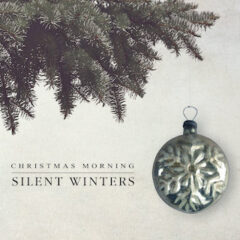 Actually, Kristin Korb—that rarity of rarities, a jazz double-bassist/lead vocalist—is an expat American now residing in Denmark with her husband, Morton Stove, co-founder of the respected microphone manufacturer, DPA Microphones. The folk duo Silent Winters, on the other hand, hail from just beyond our U.S. borders, in Ottowa, Canada. Both albums feature a pleasing mix of holiday classics of yore and more recent contributions to the seasonal catalogue. Follow this link to the full review.
Actually, Kristin Korb—that rarity of rarities, a jazz double-bassist/lead vocalist—is an expat American now residing in Denmark with her husband, Morton Stove, co-founder of the respected microphone manufacturer, DPA Microphones. The folk duo Silent Winters, on the other hand, hail from just beyond our U.S. borders, in Ottowa, Canada. Both albums feature a pleasing mix of holiday classics of yore and more recent contributions to the seasonal catalogue. Follow this link to the full review.
MOONLIGHT, MISTLETOE & YOU, Keb’ Mo’ (Concord Records, 2019 release)— On the top new Christmas album of the 2019 season (and one of 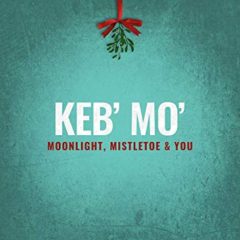 the Deep Roots Albums of the Year), Keb’ Mo’ delivers a blues-drenched gem in Moonlight, Mistletoe & You. Which is not to say Keb’ is getting lowdown and morose but rather using the blues as a platform for explaining why the spirits of the past, present and future strive within him and fully flower at Yuletide. He does so with small combo backing; lush, romantic strings and orchestra settings; and, on a couple of memorable occasions, a tight, spare trio setup. Bringing it all home vocally, he energizes the tunes with performances by turns warm and genial, moody yet uplifting—see, Keb’ always finds the silver lining in dire situations, as we learn most emphatically in his grinding take on St. Louis blues master Charley Jordan’s 1931 gem, “Santa Claus, Santa Claus,” an aching plea for the jolly old elf to “bring my baby back to me.” Follow this link to the full review.
the Deep Roots Albums of the Year), Keb’ Mo’ delivers a blues-drenched gem in Moonlight, Mistletoe & You. Which is not to say Keb’ is getting lowdown and morose but rather using the blues as a platform for explaining why the spirits of the past, present and future strive within him and fully flower at Yuletide. He does so with small combo backing; lush, romantic strings and orchestra settings; and, on a couple of memorable occasions, a tight, spare trio setup. Bringing it all home vocally, he energizes the tunes with performances by turns warm and genial, moody yet uplifting—see, Keb’ always finds the silver lining in dire situations, as we learn most emphatically in his grinding take on St. Louis blues master Charley Jordan’s 1931 gem, “Santa Claus, Santa Claus,” an aching plea for the jolly old elf to “bring my baby back to me.” Follow this link to the full review.
Christmas Stocking Stuffers: THE GATHERING, Amber Weekes; FIRST SNOW, Robert Prester & Adriana Samargia; ‘ROUND THE CHRISTMAS TREE: VINTAGE YULETIDE FAVORITES, Paragon Ragtime Orchestra— Here are three nifty items coming our way as Christmas approaches, each one reflecting a bit of a different approach to the Yuletide canon as well as offering something new and something blue(s) amidst the borrowings from yore. In The Gathering and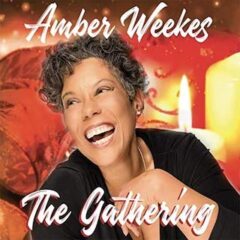 First Snow, artists Amber Weekes and the duo of Robert Prester and Adriana Samargia, respectively, make a stand for intimacy: their arrangements are, by and large, on the spare side; vocalists Weekes and Samargia tend toward the soft and warm in their deliveries; and pianist Prester often drops hints of Guaraldi in his accompaniment and solos. The outlier, if you will, in this trifecta of releases is the venerable Paragon Ragtime Orchestra’s often overlooked seasonal gem in, yes, a ragtime mode, ‘Round the Christmas Tree: Vintage Yuletide Favorites, issued in 2001 but ever so timely.
First Snow, artists Amber Weekes and the duo of Robert Prester and Adriana Samargia, respectively, make a stand for intimacy: their arrangements are, by and large, on the spare side; vocalists Weekes and Samargia tend toward the soft and warm in their deliveries; and pianist Prester often drops hints of Guaraldi in his accompaniment and solos. The outlier, if you will, in this trifecta of releases is the venerable Paragon Ragtime Orchestra’s often overlooked seasonal gem in, yes, a ragtime mode, ‘Round the Christmas Tree: Vintage Yuletide Favorites, issued in 2001 but ever so timely.
UNDER A MISTLETOE SKY, Tom Mason (www.tommason.net) (2020 release)– No stranger to holiday music, Tom Mason returns to the fold with  his third long playing entry, Under a Mistletoe Sky, a delightful addition to his seasonal catalogue, which began in 2003 with A Slide Guitar Christmas and continued in 2013 with A Pirate’s Christmas. Apparently, this album came about in early 2020 when the pandemic wiped out a UK tour with his band The Blue Buccaneers followed by the collapse of bookings here and abroad through the summer. What better way to pass the time, then, than to write and record some original songs for the coming Yuletide? Indeed, as a writer Mason blesses us with more than holly leaves and Christmas trees, as a few songs slip in overt references to social and cultural issues relevant to the national conversation of late. He keeps it jolly by keeping it edgy musically, bringing fierce energy to the original tunes via blues-rock, rock ‘n’ roll and rockabilly templates. His husky vocals seal the deal by drawing you to his messages via a multi-pronged attack of forceful conviction, unalloyed swinging when appropriate, inspired musicianship supporting him and his outstanding new tunes. Follow this link to the full review.
his third long playing entry, Under a Mistletoe Sky, a delightful addition to his seasonal catalogue, which began in 2003 with A Slide Guitar Christmas and continued in 2013 with A Pirate’s Christmas. Apparently, this album came about in early 2020 when the pandemic wiped out a UK tour with his band The Blue Buccaneers followed by the collapse of bookings here and abroad through the summer. What better way to pass the time, then, than to write and record some original songs for the coming Yuletide? Indeed, as a writer Mason blesses us with more than holly leaves and Christmas trees, as a few songs slip in overt references to social and cultural issues relevant to the national conversation of late. He keeps it jolly by keeping it edgy musically, bringing fierce energy to the original tunes via blues-rock, rock ‘n’ roll and rockabilly templates. His husky vocals seal the deal by drawing you to his messages via a multi-pronged attack of forceful conviction, unalloyed swinging when appropriate, inspired musicianship supporting him and his outstanding new tunes. Follow this link to the full review.
ROCKIN’ RUDOLPH, The Brian Setzer Orchestra Surfdog Records (2015 release, revised 2020)— Hotshot guitarist and inveterate rocker Brian Setzer, who has been responsible for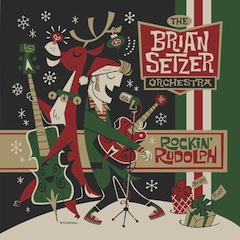 some of the liveliest Christmas music of recent times, returned to the Yuletide fold in 2015 with Rockin’ Rudolph, his first holiday album since 2005’s rousing Dig That Crazy Christmas, and his sixth seasonal-centered long player in all. His bold, brassy 18-piece orchestra is in fine shape here and gets considerable airtime, if you will, given that almost half the tunes are instrumentals on which Setzer turns them loose. … Setzer is no shrinking violet here, though. “Rockin’ Around the Christmas Tree” introduces the record with a searing blast of guitar before the host comes in to rock the vocal home while adding more stinging, howling instrumental interjections of his own, along with a sax man’s hefty solo. Follow this link to the full review.
some of the liveliest Christmas music of recent times, returned to the Yuletide fold in 2015 with Rockin’ Rudolph, his first holiday album since 2005’s rousing Dig That Crazy Christmas, and his sixth seasonal-centered long player in all. His bold, brassy 18-piece orchestra is in fine shape here and gets considerable airtime, if you will, given that almost half the tunes are instrumentals on which Setzer turns them loose. … Setzer is no shrinking violet here, though. “Rockin’ Around the Christmas Tree” introduces the record with a searing blast of guitar before the host comes in to rock the vocal home while adding more stinging, howling instrumental interjections of his own, along with a sax man’s hefty solo. Follow this link to the full review.
***
ASPECTS OF THE HOLIDAYS
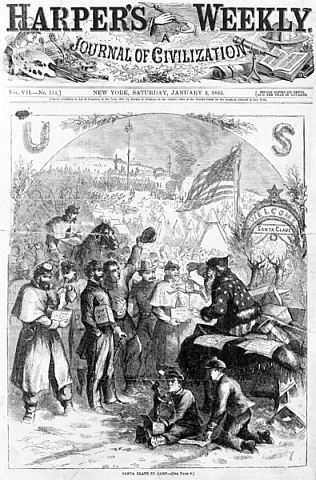
CHRISTMAS IN THE CIVIL WAR: ‘OUGHT IT NOT BE A MERRY CHRISTMAS?’
For a nation torn by civil war, Christmas in the 1860s was observed with conflicting emotions. Nineteenth-century Americans embraced Christmas with all the Victorian trappings that had moved the holiday from the private and religious realm to a public celebration. Christmas cards were in vogue, carol singing was common in public venues, and greenery festooned communities north and south. Christmas trees stood in places of honor in many homes, and a mirthful poem about the jolly old elf who delivered toys to well-behaved children captivated Americans on both sides of the Mason-Dixon line.
But Christmas also made the heartache for lost loved ones more acute. As the Civil War dragged on, deprivation replaced bounteous repasts and familiar faces were missing from the family dinner table. Soldiers used to “bringing in the tree” and caroling in church were instead scavenging for firewood and singing drinking songs around the campfire. And so the holiday celebration most associated with family and home was a contradiction. It was a joyful, sad, religious, boisterous, and subdued event.
OH HANNUKAH, OH HANNUKAH by LAURA BERMAN FORTGANG—The author, a pioneer in the personal coaching field and a best-selling author of five books now published in a dozen  languages, offers reflections on creating new traditions of Hannukah in her home that she hopes are, in turn, “creating the memories of Hannakuah that my children my write about some day. I hope I’m around to see how their kids’ Hannukah differs from theirs.”
languages, offers reflections on creating new traditions of Hannukah in her home that she hopes are, in turn, “creating the memories of Hannakuah that my children my write about some day. I hope I’m around to see how their kids’ Hannukah differs from theirs.”

The modern Santa can best be described as the creative offspring of innumerable artists and cultures, which each put their own spin on a real-life person, St. Nicholas of Myra. Plus: A Bit O’ Tree Trivia.
FRANK SINATRA: THE YULETIDE REPORT FROM THE CHAIRMAN OF THE BOARD
By David McGee
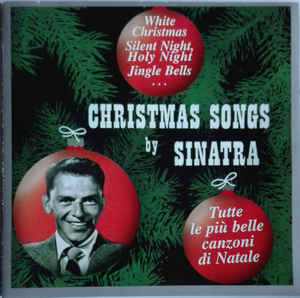
Bing Crosby popularized secular Christmas music, and then some, with his 1942 recording of Irving Berlin’s ‘White Christmas’ (later re-recorded in 1947 in the version most often heard today). However, it fell to Bing’s buddy Frank Sinatra to make an art form of Christmas music, sacred and secular alike. The producers-arrangers-conductors who helped him shape this art, and what he brought to it on his own, are the subjects of this definitive appraisal of the Chairman’s magnificent Christmas outpourings. This link will take you to the 2020 Deep Roots update of the original essay published in the December 2008 issue of TheBluegrassSpecial.com.
They are the children of all who walk the Earth, unseen

Ignorance and Want: the second of the three spirits enlightens Scrooge. From the 1984 production of A Christmas Carol starring George C. Scott.
***

VINCE GUARALDI’s score for A Charlie Brown Christmas endures as a masterpiece within a masterpiece. Here’s how it all came to be back in 1964. Originally published as a 50th Anniversary salute in the 2014 Christmas edition of www.thebluegrass.special.com; updated in 2019.
***
A HALF-CENTURY+ OF CLASSIC ANIMATED ‘RUDOLPH’: From a 50 Share to 50+ Years of Holiday Cheer

On Sunday afternoon of December 6, 1964, NBC broadcast the debut of a new Rankin/Bass Productions (Thundercats, Silverhawks, Frosty the Snowman, Frosty Returns) animated holiday tale based on the popular seasonal song by Johnny Marks, “Rudolph the Red-Nosed Reindeer,” as adapted from a poem by Robert May. It featured an animated Burl Ives in the narrator’s role, and employed a stop-motion technique with puppets, similar to George Pal’s Puppetoons, but which they promoted under the trademarked name “Animagic.” An instant holiday classic, Rudolph garnered a 50 share of the audience, a remarkable number especially in an era with fewer viewing choices than today’s TV. The year 2014 marked the 50th anniversary of the TV special, and with it the arrival of a special Collector’s Edition DVD that is both the best of times and the worst of times.

THE STORIES BEHIND THE CHRISTMAS SONGS

Pt. 1: ‘GOD REST YE MERRY GENTLEMEN’ & THE LOST PUNCTUATION MARK
What Americans hear when they listen to “God Rest Ye Merry Gentlemen” is not anything like what the English peasants meant when they first sang this song more than 500 years ago. Best selling author Ace Collins has done his research and tracked down the meanings of words fundamentally altered over time, with the end result being a wholesale distortion of the song’s original message.
Pt. 2: ‘GOD REST YE MERRY GENTLEMEN’: THE DICKENS CONNECTION
 It is the common consensus that “God Rest Ye Merry, Gentlemen” is among the most popular of carols. An early indication occurs in 1823 when antiquarian William Hone listed it as one of the 89 Christmas carols now annually printed. And he is not alone in his fondness for this carol. Twenty years later, Charles Dickens referenced the carol in his own ‘A Christmas Carol.’ Professor Wiliam Studwell, a modern authority on the origins of Christmas carols and hymns, identified ‘God Rest You Merry, Gentlemen’ as the Christmas carol of ‘A Christmas Carol,’ and pointed out how Ebenezer Scrooge could have saved himself quite an adventurous night if only he had heeded the carol’s words when he first heard them. Herein, an examination of the Dickens connection to ‘God Rest Ye Merry, Gentlemen.’
It is the common consensus that “God Rest Ye Merry, Gentlemen” is among the most popular of carols. An early indication occurs in 1823 when antiquarian William Hone listed it as one of the 89 Christmas carols now annually printed. And he is not alone in his fondness for this carol. Twenty years later, Charles Dickens referenced the carol in his own ‘A Christmas Carol.’ Professor Wiliam Studwell, a modern authority on the origins of Christmas carols and hymns, identified ‘God Rest You Merry, Gentlemen’ as the Christmas carol of ‘A Christmas Carol,’ and pointed out how Ebenezer Scrooge could have saved himself quite an adventurous night if only he had heeded the carol’s words when he first heard them. Herein, an examination of the Dickens connection to ‘God Rest Ye Merry, Gentlemen.’
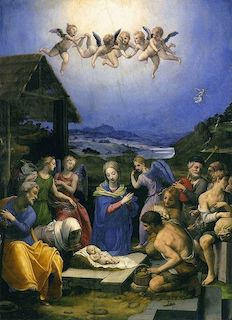
HARK THE WHAT? IRONIES OF A BELOVED CAROL
Throughout Christian history people have been changing the music. And throughout Christian history others have been getting mad about it. When my church (or our hymnal) makes some small change, usually trying to update unfamiliar language, almost always a few people will complain. Usually they’ll say something like this: “Why did you change the lyrics? Why can’t we just sing the original ones?” Yet in many cases the very words that people think are the original ones turn out not to be original at all. There’s no better illustration of this truth than the carol ‘Hark, the Herald Angels Sing.’
THE ‘QUIET ECSTASY’ OF HARRY SIMEONE’S ‘LITTLE DRUMMER BOY’
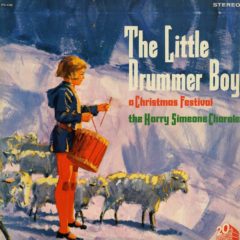 An appraisal and re-appraisal of the Harry Simeone Chorale’s woefully overlooked seasonal concept album, The Little Drummer Boy: A Christmas Festival, from which sprang the ubiquitous Yuletide classic single. A stirring achievement in and of itself, the album was released in 1958 and yet remains virtually unchallenged as a thoughtfully conceived, superbly executed mating of narrative and music. Apart from this, the song “The Little Drummer Boy” had quite an interesting journey of its own before Harry Simeone was introduced to it in 1958. In fact it dates back to 1941, when it came into being by way of American composer Katherine Kennicott Davis, who adapted the melody of an older Czech tune to lyrics she had written for a song she titled “Carol of the Drum.” The Trapp Family Singers—yes, of The Sound of Music fame—were the first to record it, in 1951; in 1957 the Jack Halloran Singers, recording for the Dot label, released an a cappella version of “Carol of the Drum” on their album Christmas Is A-Comin,’ but a projected single release of the tune never materialized. Producer Henry Onorati, who worked on the Halloran Singers project, pitched the song to his friend and fellow arranger Harry Simeone, who hired many of the Halloran Singers, added finger cymbals to it and deleted a difficult passage just before the last phrase. The rest, as the saying goes, is history, and we take it all the way back to Katherine Kennicott Davis’s original creation.
An appraisal and re-appraisal of the Harry Simeone Chorale’s woefully overlooked seasonal concept album, The Little Drummer Boy: A Christmas Festival, from which sprang the ubiquitous Yuletide classic single. A stirring achievement in and of itself, the album was released in 1958 and yet remains virtually unchallenged as a thoughtfully conceived, superbly executed mating of narrative and music. Apart from this, the song “The Little Drummer Boy” had quite an interesting journey of its own before Harry Simeone was introduced to it in 1958. In fact it dates back to 1941, when it came into being by way of American composer Katherine Kennicott Davis, who adapted the melody of an older Czech tune to lyrics she had written for a song she titled “Carol of the Drum.” The Trapp Family Singers—yes, of The Sound of Music fame—were the first to record it, in 1951; in 1957 the Jack Halloran Singers, recording for the Dot label, released an a cappella version of “Carol of the Drum” on their album Christmas Is A-Comin,’ but a projected single release of the tune never materialized. Producer Henry Onorati, who worked on the Halloran Singers project, pitched the song to his friend and fellow arranger Harry Simeone, who hired many of the Halloran Singers, added finger cymbals to it and deleted a difficult passage just before the last phrase. The rest, as the saying goes, is history, and we take it all the way back to Katherine Kennicott Davis’s original creation.
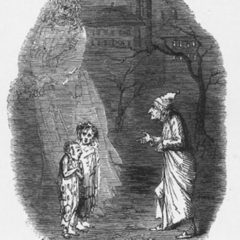
HOW MR. CHOKEPEAR KEEPS A MERRY CHRISTMAS
This piece was originally published in Punch, or The London Charivari, the beloved British weekly magazine of humor and satire established in 1841 by Henry Mayhew and engraver Ebenezer Landells. Historically, it was most influential in the 1840s and 1850s, when it helped to coin the term ‘cartoon’ in its modern sense as a humorous illustration. It became a British institution, but after the 1940s, when its circulation peaked, it went into a long decline, closing in 1992. It was revived in 1996, but closed again in 2002. “How Mr. Chokepear Keeps a Merry Christmas” was published on December 25, 1841. Its message, much as that of Dickens’s “A Christmas Carol,” which would be published two years later, on December 19, 1843, is, unfortunately, ever timely, perhaps even more so in this era of growing income inequality, attacks on the rights of workers, women and minorities, and the diminishment of the middle class. Deep Roots offers it in hopes its words will speak to the better angels of our nature.
CONVENTRY CAROL & THE SLAUGHTER OF THE INNOCENTS
The origin of the haunting carol is traced to King Herod’s Slaughter of the Innocents as described in the Gospel of St. Matthew 2: 16-18.
THE MURKY ORIGINS & EVERLASTING LIFE OF ‘JINGLE BELLS’
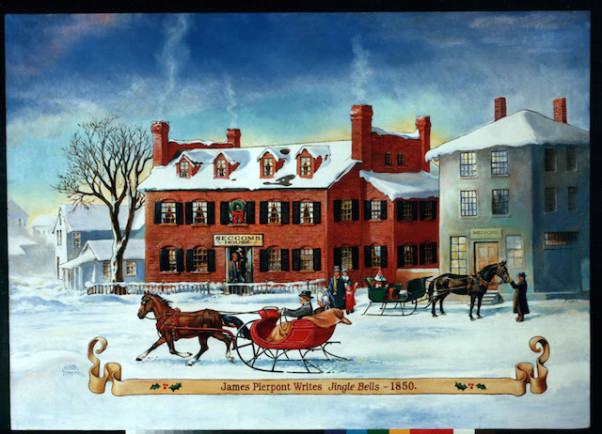
When James Lord Pierpont of Medford, Massachusetts, sat down at the piano in Simpson’s Tavern—a boardinghouse that owned the town’s only piano—and wrote a song he titled “One Horse Open Sleigh” in 1850, he wasn’t intending to give the world a jolly Christmas carol; in fact, in an undocumented but thus far irrefutable claim, scholars agree that the song was penned as a Thanksgiving treat for Pierpont’s father’s Sunday School class.
‘IT MUST HAVE BEEN THE MISTLETOE’: MANDRELL KNEW IT WAS COOL BEFORE IT WAS COOL
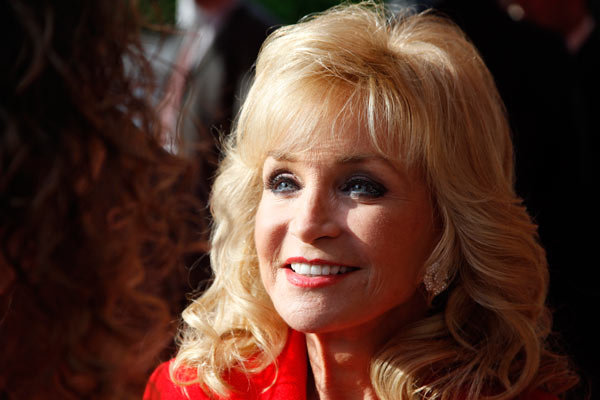
After Justin Wilde and his songwriting partner Doug Konecky had finished composing ‘It Must Have Been the Mistletoe,’ their dream of contributing a classic seasonal standard to the Christmas celebration met harsh reality: it was pitched and turned down some 376 times. Then BARBARA MANDRELL recorded it, and lo, dreams did come true.
‘DO YOU HEAR WHAT I HEAR?’: A CHRISTMAS CLASSIC FOR A NUCLEAR ARMAGEDDON
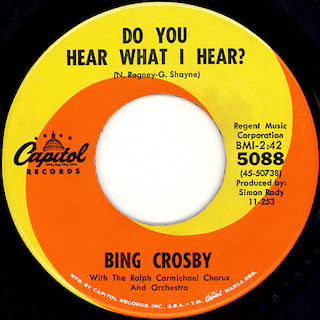 “Do You Hear What I Hear?”, one of the few Christmas songs written after 1960 to become a true seasonal standard on a par with classics such as “White Christmas,” was the product of an interfaith couple’s mutual concern for the fate of the world during the Cuban missile crisis in 1962. That listeners and critics often missed its true intent was an oversight that gnawed at the songwriters. Illustration with this entry by Phillip Light from his website, The Art of Phillip Light: Do You Hear What I Hear?
“Do You Hear What I Hear?”, one of the few Christmas songs written after 1960 to become a true seasonal standard on a par with classics such as “White Christmas,” was the product of an interfaith couple’s mutual concern for the fate of the world during the Cuban missile crisis in 1962. That listeners and critics often missed its true intent was an oversight that gnawed at the songwriters. Illustration with this entry by Phillip Light from his website, The Art of Phillip Light: Do You Hear What I Hear?
HOW WENCESLAS BECAME THE GOOD KING
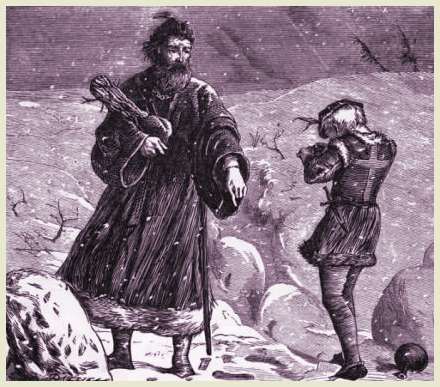
The story in song of Good King Wenceslas braving harsh winter weather to give alms to a poor peasant on the Feast of Stephen (the second day of Christmas, December 26). During the journey, his Page is about to give up the struggle against the cold weather, but is enabled to continue by following the King’s footprints, step for step, through the deep snow. The legend is based on the life of the historical Saint Wenceslaus I, Duke of Bohemia (907–935). Writing circa 1119, Cosmas of Prague describes the King’s transformative experience and exactly how he earned his regency—an explanation before the fact of how Wenceslas became the subject of a beloved Christmas carol written in 1835 by English hymn writer John Mason Neal and his music editor, Thomas Helmore.
LES OF TWO CAROLS: ‘ANGELS WE HAVE HEARD ON HIGH’ & ‘IN THE BLEAK MIDWINTER’
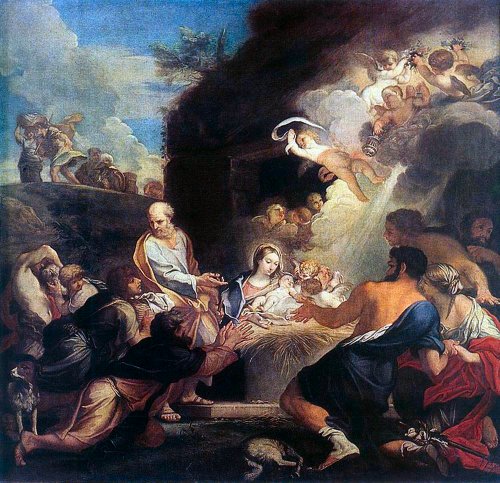
The history of two beloved Yuletide carols, ‘Angels We Have Heard On High,’ which has its origins in 18th Century France, and ‘In The Bleak Midwinter,’ based on a Christina Rossetti poem written before 1872, published in 1904 and set to Gustav Holst’s ‘Cranham’ in 1906.
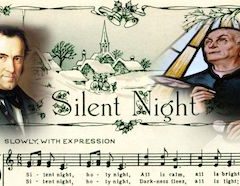 The words for the Christmas carol we know as ‘Silent Night’ were first set down on paper in 1816 in the tiny Alpine village of Mariapfarr, Austria, by Fr. Joseph Mohr. Two years later, music was added by Franz Xaver Guber and the song was performed for the first time in the Alpine village of Oberndorf, Austria, on Christmas Day, 1818. The fame of this composition spread throughout the world and 181 years later, people are still touched by both the simplicity and the strength of its message. In a five-part opus, Dr. David Nelson recounts the fascinating history behind the creation of ‘Silent Night’ and also uncovers Franz Gruber’s personal statement explaining the song’s origins.
The words for the Christmas carol we know as ‘Silent Night’ were first set down on paper in 1816 in the tiny Alpine village of Mariapfarr, Austria, by Fr. Joseph Mohr. Two years later, music was added by Franz Xaver Guber and the song was performed for the first time in the Alpine village of Oberndorf, Austria, on Christmas Day, 1818. The fame of this composition spread throughout the world and 181 years later, people are still touched by both the simplicity and the strength of its message. In a five-part opus, Dr. David Nelson recounts the fascinating history behind the creation of ‘Silent Night’ and also uncovers Franz Gruber’s personal statement explaining the song’s origins.
RUDOLPH THE RED-NOSED REINDEER: ‘YOU’LL GO DOWN IN HISTORY’—AND HOW
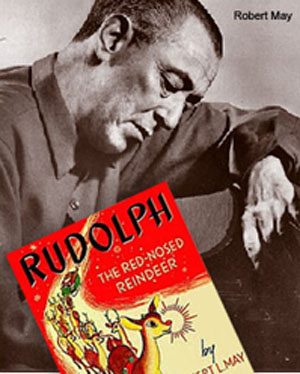
You know Dasher and Dancer and Prancer and Vixen… But do you know the real-life tragedy that spurred ROBERT MAY to make up a tale he hoped would bring comfort to his four-year-old daughter who didn’t understand why her dying mother wasn’t like other mothers. Its message, about a reindeer then named Rollo, who was outcast among Santa’s team owing to his bright red nose, evolved into a book, and then became a cultural and multimedia phenomenon, especially after his brother-in-law JOHNNY MARKS turned the story into a song. Rudolph, with his nose so bright, took flight, and he’s still soaring today. Here’s hpw it happened.
‘I HEARD THE BELLS ON CHRISTMAS DAY’
‘HOW INEXPRESSIBLY SAD ARE ALL HOLIDAYS’ describes how HENRY WADSWORTH LONGFELLOW, reeling from the death of his wife by fire and the wounding of his son in  the Civil War, composed a poem in which its author’s doubt of God’s existence is expunged by the message pealing from Yuletide bells. Herewith the true story of the events animating Longfellow’s agonizing verses and the text of the complete poem, including two stanzas directly referencing the horrors of the Civil War that were omitted in 1872 when John Baptiste Calkin arranged Longfellow’s verses into the seasonal classic expressing the triumph of good over evil in the world, ‘I Heard The Bells on Christmas Day.’ (Note: This page can be slow to load. We counsel patience.)
the Civil War, composed a poem in which its author’s doubt of God’s existence is expunged by the message pealing from Yuletide bells. Herewith the true story of the events animating Longfellow’s agonizing verses and the text of the complete poem, including two stanzas directly referencing the horrors of the Civil War that were omitted in 1872 when John Baptiste Calkin arranged Longfellow’s verses into the seasonal classic expressing the triumph of good over evil in the world, ‘I Heard The Bells on Christmas Day.’ (Note: This page can be slow to load. We counsel patience.)
‘O HOLY NIGHT’ by Douglas D. Anderson
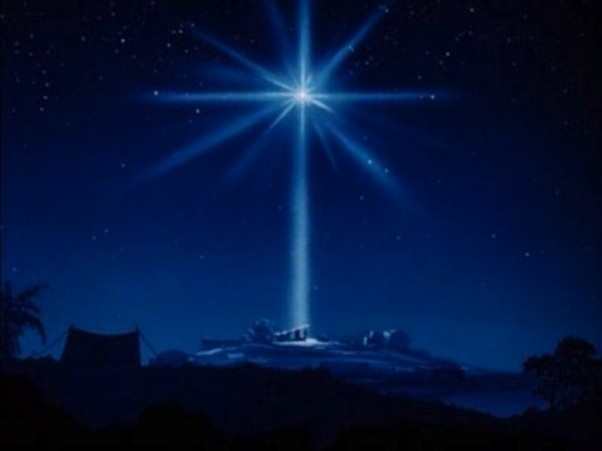
Heralded as one of the most beautiful of all Christmas carols, “O Holy Night” was not an immediate success upon its debut in 1847. The lyrics were written by Placide Cappeau, a resident of Roquemaure, France. He was a commissioner of wines, and an occasional poet. It is said that Cappeau was about to embark upon a business trip to Paris when the local parish priest asked Cappeau to write a Christmas poem. On December 3, 1847, about halfway to Paris, Cappeau received the inspiration for the poem, “Minuit, Chrétiens.” According to William Studwell, when Cappeau arrived in Paris, he took the poem to the composer Adolphe Adam (1803-1856), an acquaintance of M. and Madam Laurey who were friends of Cappeau. Adam was at the peak of his career, having written his masterpiece, Giselle, only a few years before, in 1841. He was also the composer of over 80 stage works. Adam wrote the tune in a few days, and the song received its premier at the midnight mass on Christmas Eve 1847 in Roquemaure. Notwithstanding its intrinsic beauty and initial success, the song was later attacked by churchmen in Cappeau’s native France. The reason was not because of the nature or subject of the song. Rather, the attacks were based on the reputations of the lyricist and composer. Late in his life, Cappeau was described as a social radical, a freethinker, a socialist and a non-Christian. Indeed, he adopted some of the more extreme political and social views of his era, such as opposition to inequality, slavery, injustice, and other kinds of oppression. Fortunately, more rational perspectives have prevailed. By 1855, the carol had been published in London, and it has now been translated into many languages. Douglas D. Anderson, who is responsible for the essential website The Hymns and Carols of Christmas, tell the whole tale, and includes addendums on the song’s unusual cameo in the Franco-Prussian War and concerning its first radio broadcast, in 1906.
MARVIN GAYE SINGS A CHRISTMAS SONG
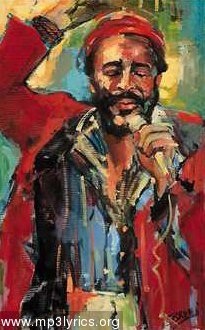
Songwriter FOREST HAIRSTON and his friend Marvin Gaye are credited as co-writers of ‘I Want To Come Home For Christmas,’ a song Gaye recorded in 1972 around the time he was working on his Trouble Man album. The song was supposed to be released as a Tamla single that year, but was withheld and did not see the light of day until 1990’s four-CD box set, The Marvin Gaye Collection. How the song came to be, what Marvin did with it, and its bittersweet aftermath are the focus of Hairston’s warm reminiscence.
***
CHRISTMAS REFLECTIONS
WHAT CHRISTMAS IS AS WE GROW OLDER

Time was, with most of us, when Christmas Day, encircling all our limited world like a magic ring, left nothing out for us to miss or seek; bound together all our home enjoyments, affections, and hopes; grouped everything and everyone around the Christmas fire; and made the little picture shining in our bright young eyes complete.
And is our life here, at the best, so constituted that, pausing as we advance at such a noticeable milestone in the track as this great birthday, we look back on the things that never were, as naturally and full as gravely as on the things that have been and are gone, or have been and still are? If it be so, and so it seems to be, must we come to the conclusion that life is little better than a dream, and little worth the loves and strivings that we crowd into it?
YES, VIRGINIA, THERE IS A SANTA CLAUS
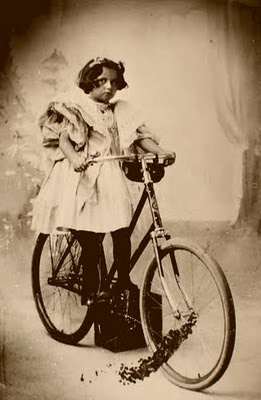
Virginia O’Hanlon
In the September 21, 1897 edition of the New York Sun, editor FRANCIS PHARCELLUS CHURCH responded to eight-year-old VIRGINIA O’HANLON’s query ‘Is there a Santa Claus’ with what became the most famous newspaper editorial in American history. Herein the complete Church response plus additional background on the dramatis personae, with illustrations and a video of the elderly Virginia O’Hanlon reading Mr. Church’s response to her query to a group of children.

VIDEO FILE
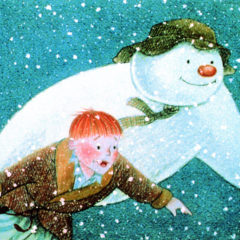 A quintet of timeless, inspired, animated Christmas tales. The feature attractions are: A pair of vintage Walt Disney Silly Symphonies—‘Santa’s Workshop’ (from 1932, with a soundtrack featuring FRANZ SCHUBERT’s ‘March Militaire’; and ‘The Night Before Christmas,’ the 1933 sequel to ‘Santa’s Workshop’; ‘Rudolph the Red-Nosed Reindeer’ (1944), the last cartoon ever produced by MAX FLEISCHER; a true oddity in ‘The Snow Man In July’ (1944). Created in Germany under the Nazi regime, this animated short was written by cartoonist Horst von Möllendorff and animated by Hans Fischerkoesen. It was animated in Potsdam, Germany, near UFA’s Neubabelsberg Studios. The original cartoon is in color but was transferred to black and white after the U.S. seized it during WWII. The story gets weirder from there.; ‘Santa’s Surprise’ (1947)– Five children from around the world follow Santa home on Christmas Eve, and decide to give him some extra help around the workshop. This cartoon introduced Little Audrey to the cartoon world. The voice talent here includes MAE QUESTEL, otherwise known as the voices of Little Audrey, Olive Oyl and, most famously, Betty Boop; ‘The Snowman,’ the 1982 animated adaption of Raymond Briggs’s award winning 1978 picture book was an Academy Award nominee and remains one of the most haunting of all seasonal films (our clip includes the David Bowie introductory scene that was cut from the American release); and another Raymond Briggs gem, a 1991 animated version blending the stories of the author’s award winning 1973 book Father Christmas and its 1975 sequel, Father Christmas Goes on Holiday.
A quintet of timeless, inspired, animated Christmas tales. The feature attractions are: A pair of vintage Walt Disney Silly Symphonies—‘Santa’s Workshop’ (from 1932, with a soundtrack featuring FRANZ SCHUBERT’s ‘March Militaire’; and ‘The Night Before Christmas,’ the 1933 sequel to ‘Santa’s Workshop’; ‘Rudolph the Red-Nosed Reindeer’ (1944), the last cartoon ever produced by MAX FLEISCHER; a true oddity in ‘The Snow Man In July’ (1944). Created in Germany under the Nazi regime, this animated short was written by cartoonist Horst von Möllendorff and animated by Hans Fischerkoesen. It was animated in Potsdam, Germany, near UFA’s Neubabelsberg Studios. The original cartoon is in color but was transferred to black and white after the U.S. seized it during WWII. The story gets weirder from there.; ‘Santa’s Surprise’ (1947)– Five children from around the world follow Santa home on Christmas Eve, and decide to give him some extra help around the workshop. This cartoon introduced Little Audrey to the cartoon world. The voice talent here includes MAE QUESTEL, otherwise known as the voices of Little Audrey, Olive Oyl and, most famously, Betty Boop; ‘The Snowman,’ the 1982 animated adaption of Raymond Briggs’s award winning 1978 picture book was an Academy Award nominee and remains one of the most haunting of all seasonal films (our clip includes the David Bowie introductory scene that was cut from the American release); and another Raymond Briggs gem, a 1991 animated version blending the stories of the author’s award winning 1973 book Father Christmas and its 1975 sequel, Father Christmas Goes on Holiday.
CHRISTMAS FICTION
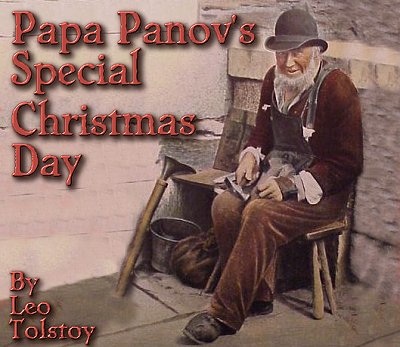
Old Papa Panov, the village shoemaker, stepped outside his shop to take one last look around. The sounds of happiness, the bright lights and the faint but delicious smells of Christmas cooking reminded him of past Christmas times when his wife had still been alive and his own children little. Now they had gone. His usually cheerful face, with the little laughter wrinkles behind the round steel spectacles, looked sad now. But he went back indoors with a firm step, put up the shutters and set a pot of coffee to heat on the charcoal stove. Then, with a sigh, he settled in his big armchair.
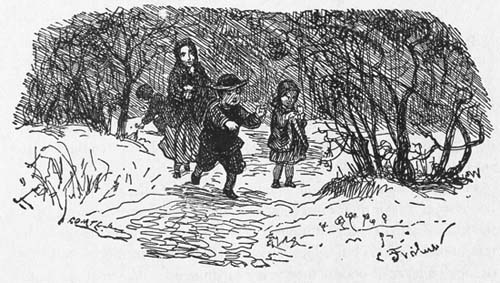
It was winter-time; the air was cold, the wind was sharp, but within the closed doors it was warm and comfortable, and within the closed door lay the flower; it lay in the bulb under the snow-covered earth.
One day rain fell. The drops penetrated through the snowy covering down into the earth, and touched the flower-bulb, and talked of the bright world above. Soon the Sunbeam pierced its way through the snow to the root, and within the root there was a stirring.
“Come in,” said the flower.

CHRISTMAS IN VERSE 2021
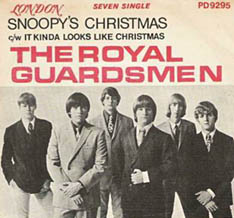 A collection of vintage Christmas poems and classic Christmas songs on video. This year’s featured poets include ALFRED, LORD TENNYSON; RICHARD SOUTHWELL; DOLLIE RADFORD; CAROLINE HAYWARD; and EDGARD ALBERT GUEST. Musical interludes are provided by THE POGUES (‘Fairytale of New York,’ with Kirsty MacColl); THE PRETENDERS (‘2000 Miles’); THE ROYAL GUARDSMEN (‘Snoopy’s Christmas’); THE SALSOUL ORCHESTRA (‘Christmas Medley’); and THE SUPREMES (‘Little Bright Star’).
A collection of vintage Christmas poems and classic Christmas songs on video. This year’s featured poets include ALFRED, LORD TENNYSON; RICHARD SOUTHWELL; DOLLIE RADFORD; CAROLINE HAYWARD; and EDGARD ALBERT GUEST. Musical interludes are provided by THE POGUES (‘Fairytale of New York,’ with Kirsty MacColl); THE PRETENDERS (‘2000 Miles’); THE ROYAL GUARDSMEN (‘Snoopy’s Christmas’); THE SALSOUL ORCHESTRA (‘Christmas Medley’); and THE SUPREMES (‘Little Bright Star’).
THE GOSPEL SET
GOSPEL AT CHRISTMASTIME—A HISTORY

When did the tradition of gospel artists recording Christmas carols begin? One is inclined to answer that Mahalia Jackson set the standard in 1950 with her Apollo recording of “Silent Night,” but the tradition goes back more than two decades before the release of Mahalia’s disc. In truth, Christmas recordings by African American sacred artists predate gospel by several years, as gospel editor Bob Marovich relates in his history of Christmas-oriented gospel music.

CHRISTMAS CLASSICS ON DVD
*‘GOD FORGIVE ME FOR THE TIME I’VE WASTED’
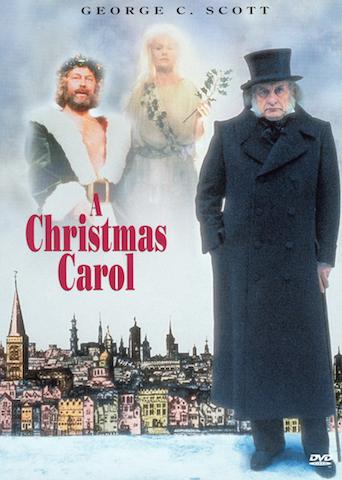
In Clive Donner’s 1984 TV adaptation of Charles Dickens’s A Christmas Carol, GEORGE C. SCOTT offers a definitive Ebenezer Scrooge in a production solid from beginning to end, with an evocative score by the brothers Bicat.
FROM THE INKWELL: AN ANIMATED CHRISTMAS—You know Dasher and Dancer and Prantzer and Vixen…and you know Miracle On 34th Street, It’s a Wonderful Life and A Christmas Story—beloved Christmas and holiday-themed movies that deserve an honored place in any video collection. Here are four more from the pantheon.
A Charlie Brown Christmas (1965)— The most beloved of all Christmas TV specials has been reissued in striking remastered color and audio, allowing a couple of generations of viewers heretofore 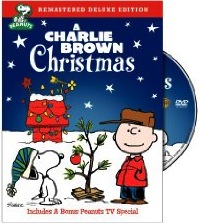 accustomed to the less vivid version previously available from Paramount to see the Yuletide travails and ultimate vindication of Charlie Brown as Baby Boomers remember it from the first national broadcast in 1965. In addition, a minor cut has been restored, so that the audio in the dance scene is in sync with all the Peanuts gang rocking out to Schroeder’s swinging keyboard stylings. Of course, the other essential ingredient is Vince Guaraldi’s impressionistic, light jazz soundtrack, his first of 15 such soundtracks for Charlie Brown specials and thus the initial installment of what became the most famous aspect of his exemplary body of work. Several of the songs here, including the beloved “Linus and Lucy” theme, were composed for the soundtrack of another Peanuts project, a 1963 documentary about Charles M. Schulz, A Boy Named Charlie Brown, and appropriated stylistic elements from jazz tunes Guaraldi had composed for how own Trio’s highly regarded jazz albums (such as the falling snowflakes effect in “Skating,” which Guaraldi had used in his tune “Ginza,” on From All Sides, one of two albums he cut with Brazilian guitar legend Bola Sete). Marvelously conceived and beautifully executed, Guaraldi’s score has become a permanent part of the Yuletide music canon.
accustomed to the less vivid version previously available from Paramount to see the Yuletide travails and ultimate vindication of Charlie Brown as Baby Boomers remember it from the first national broadcast in 1965. In addition, a minor cut has been restored, so that the audio in the dance scene is in sync with all the Peanuts gang rocking out to Schroeder’s swinging keyboard stylings. Of course, the other essential ingredient is Vince Guaraldi’s impressionistic, light jazz soundtrack, his first of 15 such soundtracks for Charlie Brown specials and thus the initial installment of what became the most famous aspect of his exemplary body of work. Several of the songs here, including the beloved “Linus and Lucy” theme, were composed for the soundtrack of another Peanuts project, a 1963 documentary about Charles M. Schulz, A Boy Named Charlie Brown, and appropriated stylistic elements from jazz tunes Guaraldi had composed for how own Trio’s highly regarded jazz albums (such as the falling snowflakes effect in “Skating,” which Guaraldi had used in his tune “Ginza,” on From All Sides, one of two albums he cut with Brazilian guitar legend Bola Sete). Marvelously conceived and beautifully executed, Guaraldi’s score has become a permanent part of the Yuletide music canon.
Frosty the Snowman/Frosty Returns (1969; 1992)— If it’s not particularly inspired, Frosty Returns, originally aired in 1992, is fun, but no match for its predecessor, 1969’s Frosty the Snowman, 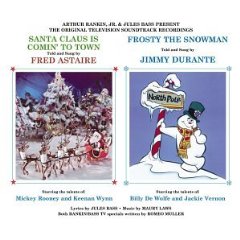 one of television’s animated classics starring Jimmy Durante as the Narrator with the voices of Jackie Vernon as Frosty and Billy DeWolfe as Professor Hinkle, the Magician. The animation is striking, as the Rankin-Bass team’s first foray into Disney-style cel animation produced a vibrant, three-dimensional feel and natural movements. The story is loosely based on the song, in which a snowman comes to life, but is developed to put Frosty into conflict with the over-ambitious Professor Hinkle, a lousy, conniving magician who believes his magic hat, so dysfunctional in his own hands but which brought Frosty to life when the kids placed it on his head, will ultimately make him a millionaire. The incomparable Durante is actually in the show as an animated character introducing the story at the beginning and returning at the end to lead a children’s parade through town, singing the title song all the way (Durante first recorded “Frosty the Snowman” back in 1950, for a 78 RPM Christmas single released on the MGM label.) He’s reason enough for this video to be in any serious Christmas collection. His new rendition of “Frosty the Snowman,” recorded almost 20 years after his first run at it, is a delight, pure Durante heart and soul in its funky delivery and easygoing good spirits.
one of television’s animated classics starring Jimmy Durante as the Narrator with the voices of Jackie Vernon as Frosty and Billy DeWolfe as Professor Hinkle, the Magician. The animation is striking, as the Rankin-Bass team’s first foray into Disney-style cel animation produced a vibrant, three-dimensional feel and natural movements. The story is loosely based on the song, in which a snowman comes to life, but is developed to put Frosty into conflict with the over-ambitious Professor Hinkle, a lousy, conniving magician who believes his magic hat, so dysfunctional in his own hands but which brought Frosty to life when the kids placed it on his head, will ultimately make him a millionaire. The incomparable Durante is actually in the show as an animated character introducing the story at the beginning and returning at the end to lead a children’s parade through town, singing the title song all the way (Durante first recorded “Frosty the Snowman” back in 1950, for a 78 RPM Christmas single released on the MGM label.) He’s reason enough for this video to be in any serious Christmas collection. His new rendition of “Frosty the Snowman,” recorded almost 20 years after his first run at it, is a delight, pure Durante heart and soul in its funky delivery and easygoing good spirits.
Disney Animation Collection 7: Mickey’s Christmas Carol (1993)– For kids and adults alike, these three Disney holiday shorts are must haves. The vintage title here is 1952’s “Pluto’s  Christmas Tree,” featuring Mickey Mouse, Pluto, Chip & Dale, chronicling the misadventures of Pluto trying to run down the two chipmunks who have invaded his prized holiday evergreen, much to Mickey’s consternation. Classic holiday mayhem, in a gentle sort of way, with no small number of humiliations visited on the beleaguered pooch. For the first time on DVD is the 1978 production, “The Small One,” being the story of a boy in Biblical times who brings his donkey to market and gives it to Joseph, to take on his journey with Mary. The gem of the set is the 1983 adaptation of Dickens’ A Christmas Carol reconfigured as Mickey’s Christmas Carol, itself an adaptation of a 1972 Disneyland Records production released on vinyl, Disney’s A Christmas Carol. Mickey is a suitably humble, hard-working Bob Cratchit, Uncle Scrooge McDuck plays his namesake Ebenezer Scrooge and is written every bit as callously as we know him to be, and Goofy is spectacular as a bumbling Marley’s ghost. Mickey’s Christmas Carol is 24 minutes of wonderful storytelling and inspired animation. It was, in fact, Disney’s first new Mickey Mouse cartoon in 30 years. Those who can locate the original VHS release of this short will find with it a special featurette on the making of Mickey’s Christmas Carol, which offers an interesting look at the Disney animation factory in the ’80s, including interviews with several of the animators and voiceover actors. Too bad that has disappeared from the DVD release.
Christmas Tree,” featuring Mickey Mouse, Pluto, Chip & Dale, chronicling the misadventures of Pluto trying to run down the two chipmunks who have invaded his prized holiday evergreen, much to Mickey’s consternation. Classic holiday mayhem, in a gentle sort of way, with no small number of humiliations visited on the beleaguered pooch. For the first time on DVD is the 1978 production, “The Small One,” being the story of a boy in Biblical times who brings his donkey to market and gives it to Joseph, to take on his journey with Mary. The gem of the set is the 1983 adaptation of Dickens’ A Christmas Carol reconfigured as Mickey’s Christmas Carol, itself an adaptation of a 1972 Disneyland Records production released on vinyl, Disney’s A Christmas Carol. Mickey is a suitably humble, hard-working Bob Cratchit, Uncle Scrooge McDuck plays his namesake Ebenezer Scrooge and is written every bit as callously as we know him to be, and Goofy is spectacular as a bumbling Marley’s ghost. Mickey’s Christmas Carol is 24 minutes of wonderful storytelling and inspired animation. It was, in fact, Disney’s first new Mickey Mouse cartoon in 30 years. Those who can locate the original VHS release of this short will find with it a special featurette on the making of Mickey’s Christmas Carol, which offers an interesting look at the Disney animation factory in the ’80s, including interviews with several of the animators and voiceover actors. Too bad that has disappeared from the DVD release.
The Snowman (1982)– If ever an animated short possessed the quality of a dream, it is The Snowman, as adapted from the Raymond Briggs children’s book. Drawn in demure pastels and shot in a 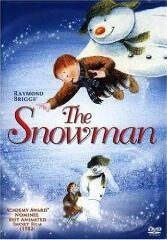 soft-focus effect, The Snowman tells the story of a young boy’s snowman who springs to life one night and spirits the lad away from his mundane existence into the land of snowmen, up north, where gaiety reigns. They dance, they sing, they make merry with Kris Kringle himself. To get there, the boy takes the snowman’s hand and they fly–oh, how they fly, through the spectacular glittering multi-colored lights of the Aurora Borealis, across a snow-covered continent, floating, soaring, gliding with a ballet dancer’s grace, all to the accompaniment of a beautiful song, “We’re Walking In the Air,” sung with ethereal plaintiveness by boy soprano Peter Autry, before alighting at the North Pole. When the festivities end, snowman and child return home; the boy awakens the next morning, anxious with delight to engage his frozen friend anew, only to find the sun has reduced him to a scarf, a hat, and a carrot that had served as his nose. As the camera pulls back, the boy, solemn, saddened, stands alone in a sea of white, mute and staring at the lone remnants of the previous night’s revelry, sustained only by his memory. Despite the bittersweet ending, The Snowman is a tale told beautifully,
soft-focus effect, The Snowman tells the story of a young boy’s snowman who springs to life one night and spirits the lad away from his mundane existence into the land of snowmen, up north, where gaiety reigns. They dance, they sing, they make merry with Kris Kringle himself. To get there, the boy takes the snowman’s hand and they fly–oh, how they fly, through the spectacular glittering multi-colored lights of the Aurora Borealis, across a snow-covered continent, floating, soaring, gliding with a ballet dancer’s grace, all to the accompaniment of a beautiful song, “We’re Walking In the Air,” sung with ethereal plaintiveness by boy soprano Peter Autry, before alighting at the North Pole. When the festivities end, snowman and child return home; the boy awakens the next morning, anxious with delight to engage his frozen friend anew, only to find the sun has reduced him to a scarf, a hat, and a carrot that had served as his nose. As the camera pulls back, the boy, solemn, saddened, stands alone in a sea of white, mute and staring at the lone remnants of the previous night’s revelry, sustained only by his memory. Despite the bittersweet ending, The Snowman is a tale told beautifully,
***
‘I asked for tenderness and depth of feeling. You have shown me that. Nothing more I need to see.’

The Ghost of Christmas Yet to Come shows Scrooge ‘the shadows of things that have not happened but will happen in the time before us…’ From the 1984 production of A Christmas Carol starring George C. Scott.

CHRISTMAS ESSENTIALS
By David McGee (unless otherwise noted)
NO WORDS NECESSARY: LEROY ANDERSON & JOHN FAHEY AT CHRISTMAS—A new John Fahey volume from Fantasy, Christmas Guitar Soli, spurs an update of our previously 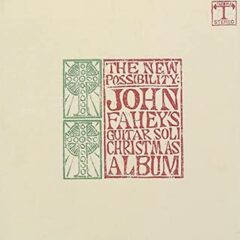 published review of A Leroy Anderson Christmas and the Rhino two-fer of Fahey’s pair of Christmas album recorded for his own Takoma label, The New Possibility: John Fahey’s Guitar Soli Christmas Album & Christmas with John Fahey, Vol. II.
published review of A Leroy Anderson Christmas and the Rhino two-fer of Fahey’s pair of Christmas album recorded for his own Takoma label, The New Possibility: John Fahey’s Guitar Soli Christmas Album & Christmas with John Fahey, Vol. II.
BALSAM RANGE, It’s Christmas Time (2017 release)— At only six songs clocking in at 18 minutes, Balsam Range’s bluegrass renderings of Yuletide gems goes by fast but memorably and movingly. One of the EP’s calling cards is the presence of the Nashville Recording Orchestra, which may not sound promising on a bluegrass outing but turns out to be a nice, measured enhancement providing a subtle extra emotional lift to the close three-part harmony perfection marking these proceedings. Doc Watson’s “Christmas Lullaby” opens the disc on a tender, rustic note with the orchestra easing unobtrusively following tasty mandolin and fiddle solos. This is the pattern throughout, and it works beautifully, especially on “The First Noel” when the strings and the soaring harmony singing produce a potent emotional pull on the listener. The pace picks up on a jaunty treatment of Johnny Marks’s “Rockin’ Around the Christmas Tree” with Buddy Melton (IBMA Male Vocalist of the Year, 2014) giving it a lively reading and Sam Levine adding a sax solo in a nod to the late, great Boots Randolph.

‘I’m Going Home, It’s Christmas,’ Balsam Range does right by a Stanley Brothers evergreen on It’s Christmas Time
The Stanley Brothers’ “I’m Going Home, It’s Christmas” (the only cut lacking orchestral backing) also struts at a sprightly pace fueled by banjo, mandolin and fiddle, is a heart tugging ode to home and hearth. But the true spirit of the season is nowhere better evoked than in the rich arrangement with soaring harmonies and complementary strings, along with vocals deeply invested in the song’s, and the season’s, message. Great work all around. –David McGee
CHRISTMAS IN ANTIQUITY, EXQUISITELY RENDERED—As related by THE BALTIMORE CONSORT in Bright Day Star, and ANONYMOUS 4 in Wolcum Yule. Plus: an exclusive interview with A4’s MARSHA GENENSKY about the making of the group’s beloved Christmas album, The Cherry Tree: Songs, Carols & Ballads for Christmas, and further discussion about the ancient texts that were A4’s musical bread and butter, the evolution of sacred music from early times to the present day, and a bit of reflecting on A4’s history.
MANDY BARNETT, Winter Wonderland–Despite a boatload of critical acclaim over the years, the expected breakthrough commercial smash has eluded Mandy Barnett. It’s unlikely a Christmas album will do what her two studio albums from the ‘90s could not do, but if one could, Winter Wonderland would be it. It is, quite simply, a virtuoso performance of sensitive, nuanced vocalizing, as good as it gets, in service and bringing fresh energy to a clutch of beloved seasonal standards.
KATHLEEN BATTLE and CHRISTOPHER PARKENING: Angels’ Glory—To the energy and intellect the marked his playing in his early professional career, Christopher Parkening has 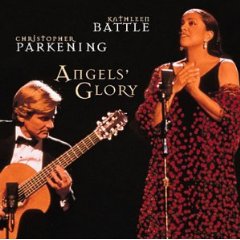 over time (notably since returning from a self-imposed retirement in the early ‘80s, during which he became a devout Christian) added restraint as another essential ingredient to his approach. He uses it as effectively as the late film director Stanley Kubrick used silence, making it an identifiable element of his art, a near-sensuous presence as a defining feature of the soundscapes he constructs with strings. It is one of the many compelling aspects of his exceptional pairing with the temperamental lyric soprano Kathleen Battle on the seasonal fare comprising Angels’ Glory.
over time (notably since returning from a self-imposed retirement in the early ‘80s, during which he became a devout Christian) added restraint as another essential ingredient to his approach. He uses it as effectively as the late film director Stanley Kubrick used silence, making it an identifiable element of his art, a near-sensuous presence as a defining feature of the soundscapes he constructs with strings. It is one of the many compelling aspects of his exceptional pairing with the temperamental lyric soprano Kathleen Battle on the seasonal fare comprising Angels’ Glory.
CLASSIC BENNETT, CLASSIC CHRISTMAS: The Season Brings Out The Best In Tony— At age 85 when his Classic Christmas Album was released, still swinging and crooning with 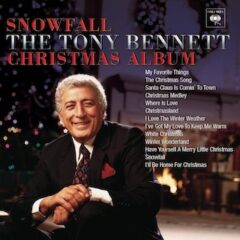 impeccable stylishness and incomparable cool, Tony Bennett was threatening his buddy Frank Sinatra’s heretofore-unchallenged supremacy in both the quantity and the quality of Christmas recordings in their respective catalogues. The year 2011 brought a splendid new anthology of the classic crooner’s Yuletide outpourings, The Classic Christmas Album, which we consider along with a genuine seasonal classic of a different name, 1968’s reissued Snowfall. The Classic Christmas Album offers 18 tracks culled from Bennett’s three solo Christmas albums–the aforementioned Snowfall, 2008’s A Swingin’ Christmas (with the Count Basie Orchestra) and a 2002 disc for Hallmark Music, Christmas With Tony Bennett–along with a track from 1998’s concept album, The Playground; and two cuts from a 2001 holiday concert in Vienna featuring Bennett, Placido Domingo, Charlotte Church and Vanessa Williams, released on CD and DVD as Our Favorite Things. This 2021 update of the original 2011 review published in TheBluegrassSpecial.com is available here.
impeccable stylishness and incomparable cool, Tony Bennett was threatening his buddy Frank Sinatra’s heretofore-unchallenged supremacy in both the quantity and the quality of Christmas recordings in their respective catalogues. The year 2011 brought a splendid new anthology of the classic crooner’s Yuletide outpourings, The Classic Christmas Album, which we consider along with a genuine seasonal classic of a different name, 1968’s reissued Snowfall. The Classic Christmas Album offers 18 tracks culled from Bennett’s three solo Christmas albums–the aforementioned Snowfall, 2008’s A Swingin’ Christmas (with the Count Basie Orchestra) and a 2002 disc for Hallmark Music, Christmas With Tony Bennett–along with a track from 1998’s concept album, The Playground; and two cuts from a 2001 holiday concert in Vienna featuring Bennett, Placido Domingo, Charlotte Church and Vanessa Williams, released on CD and DVD as Our Favorite Things. This 2021 update of the original 2011 review published in TheBluegrassSpecial.com is available here.
MARY J. BLIGE, A MARY CHRISTMAS—The millions of fans that have been buying Mary J. Blige’s albums since her 1992 debut haven’t been buying her celebrity; they’re moved by a voice with deep roots in classic soul, gospel and R&B and the intense personal commitment she makes to her lyrics. These 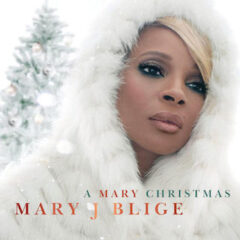 attributes are in abundant evidence on A Mary Christmas, which is nothing less than far and away the best new Christmas album of a strong 2013 season.
attributes are in abundant evidence on A Mary Christmas, which is nothing less than far and away the best new Christmas album of a strong 2013 season.
MICHAEL BUBLÉ, Christmas–Winning takes on familiar fare; a sense of history informing some of the tunes; empathetic duet partners; and thoroughly engaged vocalizing, not perfect but perfect in its intent and evincing in its many moods a sensitivity to seasonal textures: the Canadian crooner’s Christmas offering was Number One for a reason.
GLEN CAMPBELL, THAT CHRISTMAS FEELING—Finally, a domestic CD reissue of Glen Campbell’s 1968 Al De Lory-produced (-arranged-conducted) That Christmas Feeling. Two bonus 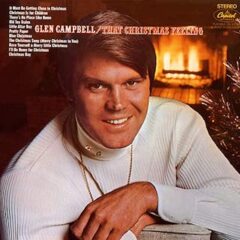 tracks from a 1969 multi-artist Yule anthology have been added to the original album’s 11 tracks to add even more luster to this most heartfelt, soulful addition to the Christmas album canon. Thus a classic restored.
tracks from a 1969 multi-artist Yule anthology have been added to the original album’s 11 tracks to add even more luster to this most heartfelt, soulful addition to the Christmas album canon. Thus a classic restored.
CANADIAN BRASS, CHRISTMASTIME IS HERE–With a discography of more than 100 albums to its credit, Canadian Brass has proven it is never at a loss for clever concepts in delivering music from across the ages in a different fashion. The quintet’s latest holiday album, Christmas Time is Here, is a fine example of this ethos at work as the beloved quintet honors the music of animated Yule specials (notably Vince Guaraldi’s score for A Charlie Brown Christmas) and the arrangements of former Brass members Luther Henderson and Brandon Ridenour.
JOHNNY CASH: CLASSIC CHRISTMAS ALBUM— For all his well-publicized spiritual backsliding, Johnny Cash was a man strong in his Christian faith, and Christmas offered him an 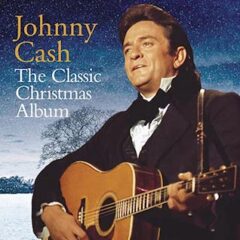 opportunity to express that faith most devoutly. Many of the songs featured here reference the Christ child’s birth and the hope of redemption and salvation He offered, as well as His legacy of love. In short, family and faith are the major themes here, so if you’re looking for something ornery, better take it on down the line.
opportunity to express that faith most devoutly. Many of the songs featured here reference the Christ child’s birth and the hope of redemption and salvation He offered, as well as His legacy of love. In short, family and faith are the major themes here, so if you’re looking for something ornery, better take it on down the line.
THE CELTS, Christmas With The Celts–Conceptually taut and flawlessly executed with all hearts on deck, Christmas With the Celts at times stretches the boundaries of seasonal music but never loses sight of seasonal verities. It will endure.
RAY CHARLES: The Spirit of Christmas— Seems odd that Ray Charles waited until 1985 to cut his first and only Christmas album, but them’s the facts. That said, working with horns, strings, the 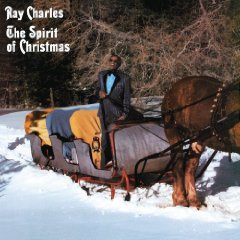 Raeletts, Jeff Pevar and Kevin Turner on guitar, Freddie Hubbard on trumpet and flugelhorn, and Rudy Johnson on tenor sax, Brother Ray does Christmas pretty much as you would expect—in his own way, never predictably, and not without some surprises along the way. For sure, among all the versions of Harry Simeone’s “Little Drummer Boy” extant, you’d be hard pressed to find one with a throbbing arrangement built on a crying steel guitar; sharp, pointed bursts of horns; keening strings; and from Ray himself, a lazy, bluesy vocal punctuated by flitting runs from his own electric piano. He puts his stamp on the song in a way other interpreters, including Frank Sinatra, simply have not done.
Raeletts, Jeff Pevar and Kevin Turner on guitar, Freddie Hubbard on trumpet and flugelhorn, and Rudy Johnson on tenor sax, Brother Ray does Christmas pretty much as you would expect—in his own way, never predictably, and not without some surprises along the way. For sure, among all the versions of Harry Simeone’s “Little Drummer Boy” extant, you’d be hard pressed to find one with a throbbing arrangement built on a crying steel guitar; sharp, pointed bursts of horns; keening strings; and from Ray himself, a lazy, bluesy vocal punctuated by flitting runs from his own electric piano. He puts his stamp on the song in a way other interpreters, including Frank Sinatra, simply have not done.
CHRISTMAS FROM WORCESTER: A Tribute to Sir David Willcocks, Worcester Cathedral Choir & CHRISTMAS FROM SELWYN, Chapel Choir of Selwyn College, Cambridge— For many people, Christmas means carols, and carols means David Willcocks (1919-2015). As a result of his involvement with, and contribution to, the seminal volumes of Carols for 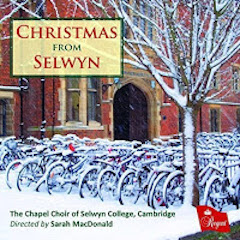 Choirs, his versions of many carols have entered the communal consciousness, and the carols selected for inclusion in the book have become standards. Between 1950 and 1957, David Willcocks was organist at Worcester Cathedral, and Christmas from Worcester has the subtitle, A Tribute to Sir David Willocks, with all the items being written and arranged by Sir David. The result is a wonderfully grand way to hear the familiar carols, with Willcocks’ brass and organ opening to “O Come, All Ye Faithful” making a great CD opener. David Willcocks arrangements open and close Christmas from Selwyn too, where the Chapel Choir of Selwyn College, Cambridge, directed by Sarah MacDonald with organist Shanna Hart and Ben Comeau, mix the popular carols with other Christmas fare. The result has a lovely intimacy, rather than Worcester’s large-scale grandeur, and the Christmas songs in popular vein are a complete delight. Reviews by Robert Hugill.
Choirs, his versions of many carols have entered the communal consciousness, and the carols selected for inclusion in the book have become standards. Between 1950 and 1957, David Willcocks was organist at Worcester Cathedral, and Christmas from Worcester has the subtitle, A Tribute to Sir David Willocks, with all the items being written and arranged by Sir David. The result is a wonderfully grand way to hear the familiar carols, with Willcocks’ brass and organ opening to “O Come, All Ye Faithful” making a great CD opener. David Willcocks arrangements open and close Christmas from Selwyn too, where the Chapel Choir of Selwyn College, Cambridge, directed by Sarah MacDonald with organist Shanna Hart and Ben Comeau, mix the popular carols with other Christmas fare. The result has a lovely intimacy, rather than Worcester’s large-scale grandeur, and the Christmas songs in popular vein are a complete delight. Reviews by Robert Hugill.
CHRISTMAS THE MOUNTAIN WAY (Various Artists)—A CD/DVD combo from a show earlier this year in Pineville, Kentucky, featuring some of the top names in traditional bluegrass celebrating the true meaning of Christmas in familiar carols and a couple of new tunes written especially for this occasion. DALE ANN BRADLEY, STEVE GULLEY, MARTY RAYBON, COMMON STRINGS, CUMBERLAND RIVER, MIKE SCOTT and DEBBIE GULLEY are among the impressive roster of top-tier bluegrassers who make this an essential Christmas offering from the Rural Rhythm label.
NAT KING COLE: The Christmas Song, Like No Other Christmas Song—Christmas is illegal without Nat King Cole, right? Surely it would violate the laws of this land for a season to pass  without the reassuring tones of the man with the smoky grey voice blessing us with a comforting “Merry Christmas…to you,” his annual benediction reaffirming warm tidings of home, family and seasonal traditions, unsullied by cynicism, untouched by post-modern angst.
without the reassuring tones of the man with the smoky grey voice blessing us with a comforting “Merry Christmas…to you,” his annual benediction reaffirming warm tidings of home, family and seasonal traditions, unsullied by cynicism, untouched by post-modern angst.
A MERRY CHRISTMAS WITH BING CROSBY & THE ANDREWS SISTERS–Few male-female vocal pairings of a holiday nature summoned the  festive and the reflective spirit of the season alike with more grace and conviction than that of Bing Crosby and Andrews Sisters Patty, LaVerne and Maxene. This 20-track collection contains all six of the wonderful Crosby-Andrews Sisters pairings on record, a couple from 1950, the others from the ‘40s, dating back to 1943’s double-sided gold-certified hit single, “Santa Claus Is Comin’ To Town” b/w “Jingle Bells.”
festive and the reflective spirit of the season alike with more grace and conviction than that of Bing Crosby and Andrews Sisters Patty, LaVerne and Maxene. This 20-track collection contains all six of the wonderful Crosby-Andrews Sisters pairings on record, a couple from 1950, the others from the ‘40s, dating back to 1943’s double-sided gold-certified hit single, “Santa Claus Is Comin’ To Town” b/w “Jingle Bells.”
BING CROSBY and LOUIS ARMSTRONG: a Yule without Der Bingle or Satchmo would be comparable to finding a lump of coal in the stocking on Christmas morn.
DALLAS WIND SYMPHONY, Horns for the Holidays— If you are a lover of Christmas music—carols, popular songs, and all manner of medleys and clever arrangements of such—and you miss this extraordinary recording by the first-rate Dallas Wind Symphony, then your holiday listening stands to be just a bit more dull, less festive, and more ordinary than it could have been. This is a terrific program, in exemplary sound, that botht celebrates the Christmas music tradition even as it exemplifies the best of the wind ensemble genre.
DORIS DAY, Complete Christmas Collection–Only one Doris Day Christmas album exists, from 1964, and its title is as straightforward as her singing: The Doris Day Christmas Album. The folks 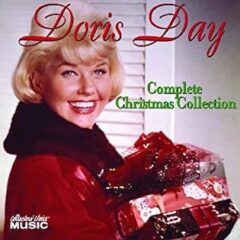 at Collectors’ Choice, however, have included another nine tracks of Christmas fare, most from non-album singles sides, and put it all together on one CD as Complete Christmas Collection. It’s pretty amazing and pretty much beyond criticism–oh, you can hear her strain for a couple of fleeting moments when she tries to belt out a refrain, but she quickly reins it back in and makes a smooth, seamless transition back to the original melody line and to the vocal place where she thrives. Wonderful technique is at work in all of Day’s recordings, but what she wrought in her Christmas material is something beyond technique, something abiding in the exalted realm of the heart, where pure feeling produces the peace that passes all understanding. This is beautiful.
at Collectors’ Choice, however, have included another nine tracks of Christmas fare, most from non-album singles sides, and put it all together on one CD as Complete Christmas Collection. It’s pretty amazing and pretty much beyond criticism–oh, you can hear her strain for a couple of fleeting moments when she tries to belt out a refrain, but she quickly reins it back in and makes a smooth, seamless transition back to the original melody line and to the vocal place where she thrives. Wonderful technique is at work in all of Day’s recordings, but what she wrought in her Christmas material is something beyond technique, something abiding in the exalted realm of the heart, where pure feeling produces the peace that passes all understanding. This is beautiful.
BOB DYLAN, Christmas From the Heart By Billy Altman—I think it’s safe to say that, were he so inclined, Bob Dylan would probably be having himself a merry little “Ho ho ho” surveying all the furrowed-brow commentary surrounding the “meaning” of his Christmas In The Heart. The CD finds Dylan 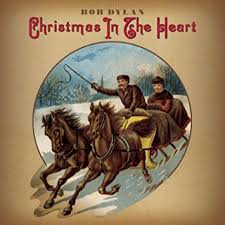 delivering disarmingly straightforward renditions of fifteen Yuletide tunes, all of which have been part of our collective consciousness since everyone’s childhood. As he’s periodically demonstrated throughout his near half-century in the public eye, Dylan is an artist who at his core really does understand and respect the value of tradition.
delivering disarmingly straightforward renditions of fifteen Yuletide tunes, all of which have been part of our collective consciousness since everyone’s childhood. As he’s periodically demonstrated throughout his near half-century in the public eye, Dylan is an artist who at his core really does understand and respect the value of tradition.
HARMONIE ENSEMBLE New York: TCHAIKOVSKY, ELLINGTON & STRAYHORN: NUTCRACKER SUITES (Conductor: Steven Richman)— Since releasing its first album in 1990, Harmonie 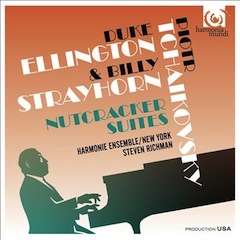 Ensemble/New York, founded by conductor/music director Steven Richman, has been predictably unpredictable in its program choices and even more so in how it approaches those choices. Works by Copland, Grofé, Stravinsky, Dvorak and Gershwin adorn the ensemble’s catalog and all have received enthusiastic reviews. Richman and Ensemble scored a major triumph in 2010 in revisiting the Miles Davis/Gil Evans jazz landmark Sketches of Spain with veteran trumpeter Lew Soloff (who, in addition to his many other credits, joined Evans for two albums in the ‘70s and has been a longtime member of the Manhattan Jazz Quintet). While respecting the original recording, Richman’s arrangements added new texture and color that, as critics agreed, enhanced the strengths of the Davis/Evans collaboration by injecting striking personal touches that evokes, as, as one reviewer said, “a Spain that existed in Evans’ musical imagination. ”The Ensemble’s latest foray into the classical/jazz realm in the form of not one but two versions of Tchaikovsky’s The Nutcracker Suite ballet music. The first is a straight-ahead, beautifully arranged recording of the original score, as you might hear it every year at this time at the New York City Ballet’s annual Nutcracker productions at Lincoln Center. The second honors the Duke Ellington-Billy Strayhorn Nutcracker with a Harmonie Ensemble jazz lineup of musicians making a run at it following its faithful orchestral rendition of Tchaikovsky’s score. For some, one Nutcracker a year is likely quite enough but Steve Richman and the crack lineup he’s assembled in the Harmonie Ensemble New York lend musical heft to legendary Chicago Cubs shortstop Ernie Banks’s classic cry of “Let’s play two!” They did, and they won both ends of the doubleheader.
Ensemble/New York, founded by conductor/music director Steven Richman, has been predictably unpredictable in its program choices and even more so in how it approaches those choices. Works by Copland, Grofé, Stravinsky, Dvorak and Gershwin adorn the ensemble’s catalog and all have received enthusiastic reviews. Richman and Ensemble scored a major triumph in 2010 in revisiting the Miles Davis/Gil Evans jazz landmark Sketches of Spain with veteran trumpeter Lew Soloff (who, in addition to his many other credits, joined Evans for two albums in the ‘70s and has been a longtime member of the Manhattan Jazz Quintet). While respecting the original recording, Richman’s arrangements added new texture and color that, as critics agreed, enhanced the strengths of the Davis/Evans collaboration by injecting striking personal touches that evokes, as, as one reviewer said, “a Spain that existed in Evans’ musical imagination. ”The Ensemble’s latest foray into the classical/jazz realm in the form of not one but two versions of Tchaikovsky’s The Nutcracker Suite ballet music. The first is a straight-ahead, beautifully arranged recording of the original score, as you might hear it every year at this time at the New York City Ballet’s annual Nutcracker productions at Lincoln Center. The second honors the Duke Ellington-Billy Strayhorn Nutcracker with a Harmonie Ensemble jazz lineup of musicians making a run at it following its faithful orchestral rendition of Tchaikovsky’s score. For some, one Nutcracker a year is likely quite enough but Steve Richman and the crack lineup he’s assembled in the Harmonie Ensemble New York lend musical heft to legendary Chicago Cubs shortstop Ernie Banks’s classic cry of “Let’s play two!” They did, and they won both ends of the doubleheader.
THE ELLINGTONIAN NUTCRACKER by IRVING TOWNSEND— From the liner notes published on the back cover of the 1960 Columbia Records release of The Nutcracker Suite as performed by Duke Ellington and Billy Strayhorn: In his liner notes, Townsend, a revered producer who steered Miles Davis’s 1959 masterpiece, King of Blue (the best selling jazz album of all time), discusses the origins of The Nutcracker Suite and offers a track-by-track description of Ellington’s reimagine of Tchaikovsky’s ballet score (as well as a fantasy sequence involving Ellington and Tchaikovsky meeting in Las Vegas while the former was holding forth at The Riviera. If only… Also reviewed here: DUKE ELLINGTON: THREE SUITES, a 2008 release featuring three Ellington-Strayhorn suites: The Nutcracker; Grieg’s Peer Gynt Suites 1 & 2; and their own Suite Thursday.
FARMER JASON, CHRISTMAS ON THE FARM— This much is guaranteed: you’ll find no other Christmas album for this season as warm-hearted, warm and downright funny as Jason  Ringenberg’s (aka Farmer Jason) Christmas on the Farm. Being nothing less than a holiday lesson for kids in the important role animals of all kinds play in everyday life and did play in the Christmas Story, Christmas On the Farm embraces Farmer Jason’s past as neo-honky tonk punk rocker (as the titular head of Nashville’s awesome Jason & The Scorchers) to advance its messages with a twang here, a backwoods country drawl of a vocal there and with what the Pogues’ late, great Philip Chevron called “a punk rock kick in the arse.” To accomplish this Farmer Jason—the rural personal Ringenberg adopted a decade or so ago—enlisted the formidable assistance of producers Thomas Jutz and Peter Cooper, and further enlisted Jutz to do something else he excels at—playing rootsy, dynamic guitar—added Mark Fain on bass and Lynn Williams on percussion and got some other expert assistance from the likes of Sierra Hull (mandolin), Steve Herman (trumpet), Fats Kaplin (steel guitar and fiddle), Kelli Workman (piano), Dave Roe and Molly Felder (vocals), a memorable guest appearance by Webb Wilder, and even a couple of other Ringenbergs—his daughters Addie Rose on vocal and Camille on flute joining in to create a charming, lilting rendition of “Away In a Manger” that evokes the solemnity and tenderness of the Christ child’s birth night with the animals lowing beside Him protectively.
Ringenberg’s (aka Farmer Jason) Christmas on the Farm. Being nothing less than a holiday lesson for kids in the important role animals of all kinds play in everyday life and did play in the Christmas Story, Christmas On the Farm embraces Farmer Jason’s past as neo-honky tonk punk rocker (as the titular head of Nashville’s awesome Jason & The Scorchers) to advance its messages with a twang here, a backwoods country drawl of a vocal there and with what the Pogues’ late, great Philip Chevron called “a punk rock kick in the arse.” To accomplish this Farmer Jason—the rural personal Ringenberg adopted a decade or so ago—enlisted the formidable assistance of producers Thomas Jutz and Peter Cooper, and further enlisted Jutz to do something else he excels at—playing rootsy, dynamic guitar—added Mark Fain on bass and Lynn Williams on percussion and got some other expert assistance from the likes of Sierra Hull (mandolin), Steve Herman (trumpet), Fats Kaplin (steel guitar and fiddle), Kelli Workman (piano), Dave Roe and Molly Felder (vocals), a memorable guest appearance by Webb Wilder, and even a couple of other Ringenbergs—his daughters Addie Rose on vocal and Camille on flute joining in to create a charming, lilting rendition of “Away In a Manger” that evokes the solemnity and tenderness of the Christ child’s birth night with the animals lowing beside Him protectively.
ELLA FITZGERALD: And A Swinging Christmas To You, Too— 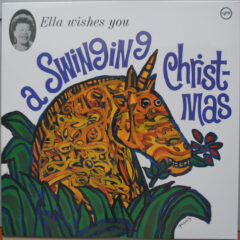 Remastered and reissued in 2002, the First Lady of Song’s only album-length collection of secular Christmas songs ranks with the finest efforts of her gifted peers, such as those of her staunch fan and supporter Frank Sinatra, for one. The original 12-song LP has been augmented here by six bonus tracks. Three of those are alternate takes of songs on the album, but two-an absolutely haunting, and stately, medley of “We Three Kings of Orient Are” and a cheery holiday fantasy, “Christmas Island”-had previously been available only on a 45 issued in England, and the other, “The Secret of Christmas,” was the B side of her 1959 single of “The Christmas Song.” “The Secret of Christmas,” soft and hymn-like in its somber tempo, delicate wash of strings and soft-plucked harp, is a real gem.
Remastered and reissued in 2002, the First Lady of Song’s only album-length collection of secular Christmas songs ranks with the finest efforts of her gifted peers, such as those of her staunch fan and supporter Frank Sinatra, for one. The original 12-song LP has been augmented here by six bonus tracks. Three of those are alternate takes of songs on the album, but two-an absolutely haunting, and stately, medley of “We Three Kings of Orient Are” and a cheery holiday fantasy, “Christmas Island”-had previously been available only on a 45 issued in England, and the other, “The Secret of Christmas,” was the B side of her 1959 single of “The Christmas Song.” “The Secret of Christmas,” soft and hymn-like in its somber tempo, delicate wash of strings and soft-plucked harp, is a real gem.
ARETHA FRANKLIN: Making Believers Of Us All—Whether live or in the studio on Joy To The World, Aretha Franklin is never far from the gospel highway–the church infuses everything she does here. So mark this one a seasonal keeper, by the sheer force of Aretha’s unassailable artistry and bountiful spirit. She’ll make a believer of you, in many ways.
THE GATHERING–It has a certain magic about it, this music, in the seeming ease of its instrumental virtuosity coupled to a spirit of friendship and common cause—there is not a moment on The Gathering that doesn’t sound free and impassioned, musicians having a great time playing with each other and giving their hearts to the task at hand. A memorable Christmas moment by way of the gathered artistry of Laurelyn Dossett; the Carolina Chocolate Drops’ Rhiannon Giddens; the John Hartford and Nashville Bluegrass Bands’ Mike Compton; multi-instrumentalist Joe Newberry; and double-bassist Jason Sypher.
HEREFORD CATHEDRAL CHOIR, Christmas from Hereford—A lovely and unusual disc, this cozy, gentle and varied collection of Christmas music from Hereford Cathedral is broken into three sections: Advent, Christmas, and Epiphany. The music ranges from the 14th-century Resonemus laudibus, a joyous piece arranged with a fanciful organ part by David Willcocks to offset the rigidity of the medieval melody, to a work by John Tavener (his glorious—and only—brief masterpiece, The Lamb), with stops in between, in each of the three sections, for one of Mendelssohn’s short but imposing Op. 79 motets.
HOT CLUB OF SAN FRANCISCO, COOL YULE— –Working in different guises frees the Hot Club musicians from strict adherence to approaching everything as le jazz hot. So, for example,  you get a soothing, sensual treatment of “Baby, It’s Cold Outside” complete with strings that give it a late night, saloon song vibe, although Paul Mehling’s guitar and Evan Price’s fiddle soloing adds a tasty Django-Grappelli feel. The flirty, engaging vocal duo delivering the goods here is billed as Duo Gadja, which is, in fact, Isabelle Fontaine and Jeff Magidson. Or you get “Don Rodolfo,” a version of “Rudolph the Red-Nosed Reindeer” reimagined as a smoldering tango (it even includes a segment from Bizet’s Carmen (really—the “Habanera” aria). Or dig a truly delightful take on Victor Herbert’s “March of the Toys” from the Babes in Toyland operetta that breaks out of its stately march beginnings into a full-on hot swing romp fueled by Mehling’s dazzling lead guitar, Evan Price’s colorful fiddling and Sam Rocha’s furious clacking bass steering this runaway sleigh.
you get a soothing, sensual treatment of “Baby, It’s Cold Outside” complete with strings that give it a late night, saloon song vibe, although Paul Mehling’s guitar and Evan Price’s fiddle soloing adds a tasty Django-Grappelli feel. The flirty, engaging vocal duo delivering the goods here is billed as Duo Gadja, which is, in fact, Isabelle Fontaine and Jeff Magidson. Or you get “Don Rodolfo,” a version of “Rudolph the Red-Nosed Reindeer” reimagined as a smoldering tango (it even includes a segment from Bizet’s Carmen (really—the “Habanera” aria). Or dig a truly delightful take on Victor Herbert’s “March of the Toys” from the Babes in Toyland operetta that breaks out of its stately march beginnings into a full-on hot swing romp fueled by Mehling’s dazzling lead guitar, Evan Price’s colorful fiddling and Sam Rocha’s furious clacking bass steering this runaway sleigh.
DAVID IAN, Vintage Christmas Trio (Prescott Records, 2017 release)– One wag has unfairly characterized David Ian’s third Vintage Christmas outing (following 2011’s Vintage Christmas and 2014’s Vintage Christmas Wonderland) as “another ‘Charlie Brown’s Christmas,’” suggesting that this all-instrumental trio project must inevitably be compared to and fall short of the majesty of Vince Guaraldi’s Yuletide masterpiece. Take a breath, please. Ian (on piano), Jon Estes (bass) and Josh Hunt (drums) fashion a casual feel, but of course this stems from musicians so skilled as to make you believe they were just jamming on some holiday favorites, with no particular destination in mind, and someone happened to capture their musical conversation on some kind of recording device, perhaps surreptitiously. And whereas Ian doesn’t get so far out as to lose the essence of the basic texts, his variations on the melodies take the tunes to places even Guaraldi never went—“Good King Wenceslas” evolves from its tried-and-true melody into a wistful classic pop ballad feel before the bass falls away, leaving Ian to restate the main melodic theme in spare, music-box style while Hunt underpins it on brushes with a soft shuffle rhythm.

‘Good King Wenceslas,’ David Ian, Vintage Christmas Trio
Similarly, a section of “It Came Upon a Midnight Clear” departs from the melody and heads for blues territory in a series of triplet runs and forceful chording. “I Heard The Bells On Christmas Day” is rendered with more glide in its stride than it usually gets, thanks to the hints of dissonance in Ian’s chording and Estes’s ruminative, low-key bass solo, which may be the first time this beloved warhorse has ever featured a bass solo. So come, all ye faithful, set your preconceived notions aside and prepare to be surprised by the new twists Ian and company work on these ageless wonders of the Christmas canon. –David McGee
JACKSON 5: ULTIMATE CHRISTMAS COLLECTION—The original Jackson 5 Christmas Album, though less introspective and minus the spirituality of Yuletide long players by labelmates Smokey Robinson & the Miracles and Stevie Wonder, is a classic Christmas album nonetheless simply for doing what the Jacksons were doing so well back then—speaking to their audience with a lot of heart and abundant, infectious energy. The original 11-song LP is remembered for its high spirits and hard charging performances; the Ultimate version of the J5 Christmas album is fleshed out with spoken Season’s Greetings from four of the five brothers (including Michael), and six other musical tracks. The original album, though, remastered and reissued on CD in 1993, will do just fine for those on a budget or preferring an undiluted Jackson 5 holiday bonanza.
ALAN JACKSON: Right At Home For Christmas—Two very different approaches to Christmas music are defined in Alan Jackson’s Yuletide long players. Honky Tonk Christmas, released in  1993, came near the beginning of Jackson’s hit-filled career, and it emphasizes his reverence not only for the season but for the style of country music he prefers and has made his trademark when other artists of his generation and younger are recycling ’80s arena rock riffs. Let It Be Christmas, from 2002, is from an artist at the top of his game, assured enough to broaden out his basic band with orchestra, strings and a large background chorus, adopting a soft, dreamy pop ambience in stark contrast to the stripped down approach of its holiday predecessor.
1993, came near the beginning of Jackson’s hit-filled career, and it emphasizes his reverence not only for the season but for the style of country music he prefers and has made his trademark when other artists of his generation and younger are recycling ’80s arena rock riffs. Let It Be Christmas, from 2002, is from an artist at the top of his game, assured enough to broaden out his basic band with orchestra, strings and a large background chorus, adopting a soft, dreamy pop ambience in stark contrast to the stripped down approach of its holiday predecessor.
GEORGE JONES & TAMMY WYNETTE: CLASSIC CHRISTMAS ALBUM— Give compilation producer Gregg Geller credit for bringing a sense of humor to the task of compiling tracks for the George Jones & Tammy Wynette Classic Christmas Album entry. Granted, he didn’t have a Sinatra-like wealth of holiday outpourings from which to choose, so maybe it’s not so surprising that, apart from the traditional favorites here, the album breaks down to Possum taking the lead on songs despairing of the holidays bringing anything but misery and Tammy balancing the scales with positive, upbeat or inspirational forecasts.
B.B. KING: A SOUL EVERY MORE GRATEFUL FOR WHAT IT KNOWS OF LOVE– The interesting fact about B.B. KING‘s first Christmas album is how the sum of the parts adds up to 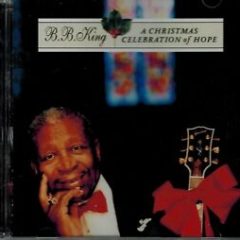 something greater than what went down in Maurice, Louisiana’s Dockside Studios in June 2001. Taken individually, the performances on the album are warm and ingratiating enough, appropriate to the season, some treated in a lighthearted manner, a couple of blues getting down into the depths of feeling; but when it’s all over, a spell lingers. There’s something special about the imprint B.B. puts on these songs–the conviction in his voice, the personality he projects throughout, Lucille’s sunny tone—and when that’s coupled to his road band’s high spirited accompaniment the end result is a model Yuletide blues album that sneaks up on a listener.
something greater than what went down in Maurice, Louisiana’s Dockside Studios in June 2001. Taken individually, the performances on the album are warm and ingratiating enough, appropriate to the season, some treated in a lighthearted manner, a couple of blues getting down into the depths of feeling; but when it’s all over, a spell lingers. There’s something special about the imprint B.B. puts on these songs–the conviction in his voice, the personality he projects throughout, Lucille’s sunny tone—and when that’s coupled to his road band’s high spirited accompaniment the end result is a model Yuletide blues album that sneaks up on a listener.
NANCY LAMOTT, Suffused With Beauty— Nancy Lamott and beauty were on intimate terms. It radiated from her warm personality, resonated in her tender vocals, and suffused the recordings 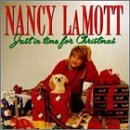 she made before succumbing to cancer in 1995 at age 43. Disc jockey Jonathan Schwartz declared Lamott the finest cabaret singer since the Chairman of the Board, praise well earned by Lamott and thoughtfully dispensed by Schwartz. Like Sinatra, Lamott sought out literate songs with a folksy quality–the settings may have been urbane, but the feelings were universal. The Great American Songbook has rarely had so effective an advocate as Nancy Lamott. Her lone Christmas album, Just In Time for Christmas, is a crash course in all that was remarkable about this gifted artist.
she made before succumbing to cancer in 1995 at age 43. Disc jockey Jonathan Schwartz declared Lamott the finest cabaret singer since the Chairman of the Board, praise well earned by Lamott and thoughtfully dispensed by Schwartz. Like Sinatra, Lamott sought out literate songs with a folksy quality–the settings may have been urbane, but the feelings were universal. The Great American Songbook has rarely had so effective an advocate as Nancy Lamott. Her lone Christmas album, Just In Time for Christmas, is a crash course in all that was remarkable about this gifted artist.
RICK LANG, Christmas, Close to Home, Hearth and Heart— Songwriter Rick Lang has endeared himself to the bluegrass and bluegrass gospel worlds with his eloquent, well-crafted tunes, commitment to his craft and personal warmth. His second seasonal album, That’s What I Love About Christmas, is only going to elevate the respect he’s gained over the years.
With the help of producer-guitarist-vocalist Stephen Mougin, Lang has found his new batch of Christmas songs presented in ways he hadn’t expected but has found pleasantly surprising. After hearing some of the first tunes Lang had completed, Mougin offered as to how he could hear them in a small combo jazz-influenced style. Keeping things tight, economical and reflective in mood gives That’s What I Love About Christmas an intimate, chamber-like quality; and though the ambience is serene, it’s not melancholy—even the reverent readings of “Angels From On High” and “Prepare a Place for Him,” by crystalline-voiced Jane Mougin (the latter tune also featuring affecting background harmony vocals by Darin and Brooke Aldridge and Amy Darrow) are upbeat in message.
GOOD TIDINGS FROM LITTLE MISS DYNAMITE: Brenda Lee Makes Christmas Memorable—From “Rockin’ Around the Christmas Tree” to “Papa Noel” to “Christmas Time Is 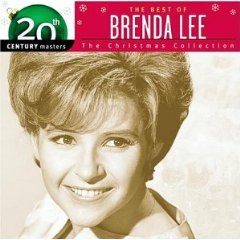 Near,” the 18 tracks comprising The Best of Brenda Lee: The Christmas Collection, so unassuming in its design, assay a wide range of feelings, and illustrates anew the great synergy between producer Owen Bradley and artist BRENDA LEE. All those enduring pop and country hits were no accident, and the performances herein, though less well known, are standing the test of time quite well, too, thank you.
Near,” the 18 tracks comprising The Best of Brenda Lee: The Christmas Collection, so unassuming in its design, assay a wide range of feelings, and illustrates anew the great synergy between producer Owen Bradley and artist BRENDA LEE. All those enduring pop and country hits were no accident, and the performances herein, though less well known, are standing the test of time quite well, too, thank you.
LOS ROMEROS, CHRISTMAS WITH LOS ROMEROS— In a world whose centrifugal globalizing powers are stretching the fibers of closely-knit tribal units to breaking point, the final days  of December don’t just mark a time of stability, but of unity: Having mostly sacrificed its religious meaning in favor of commerce, Christmas, to most, has retained its significance by remaining a family ritual. So it should seem only consequential that Los Romeros should finally record their first Christmas album after half a century at the pole position of the guitar quartet, a genre they have made their own like few others.
of December don’t just mark a time of stability, but of unity: Having mostly sacrificed its religious meaning in favor of commerce, Christmas, to most, has retained its significance by remaining a family ritual. So it should seem only consequential that Los Romeros should finally record their first Christmas album after half a century at the pole position of the guitar quartet, a genre they have made their own like few others.
NICK LOWE, QUALITY STREET: A SEASONAL SELECTION FOR ALL THE FAMILY— Nick Lowe might not immediately spring to mind as an artist you’d expect to find releasing a Christmas album—he can, after all, come off as curmudgeonly and unsentimental, much closer in spirit to Ebenezer Scrooge than to Bob Cratchit. But when his new label home, Yep Roc, suggested a holiday project, he took it under advisement and shortly thereafter bought in. The result, Quality Street, fulfills his vision, and comes complete with a subtitle that might strike some fans as being quintessentially snarky in a Nick Lowe kind of way but is in fact completely sincere. He keeps Christmas well.
RAUL MALO, Marshmallow World & Other Holiday Favorites (2007)– In one of the most classic of The Honeymooners’ Classic 39 episodes, “Alice and The Blonde,” Ralph Kramden’s 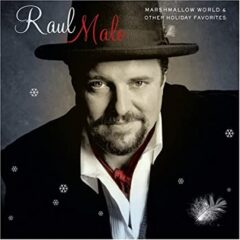 sidekick, subterranean sanitation worker Ed Norton compliments Burt Weidemeyer on the appearance of the Weidemeyer apartment (newly inhabited by Burt’s blushing bride, the “Blonde” of the episode title, who boasts a decided Jayne Mansfield flair about her) by declaring it to be “suave. That’s a long-winded way to make the point that Raul Malo’s stunner of a Christmas album, the benignly (or retro-) titled Marshmallow World & Other Holiday Favorites, is many things, all marvelous, but mostly it is suave like nobody’s business–much like Malo himself, come to think about it. Working economically, Malo assembled seven other musicians to support him, all but two (John McTigue III on drums, Neil Rosengarden on trumpet) playing multiple instruments. Malo himself works out on four instruments–including the Danelectro baritone guitar with the deep, fat twang that has become a mainstay of Malo’s sound–and his catholic touch is all over the arrangements, which range from big band swing, to cheery R&B, to saloon-style blues, to south of the border flavors; but in the end, for all his mastery of every aspect of his art, Malo’s voice and scintillating attack, so unpredictable and so richly informed by history, puts this album in league with the finest holiday albums of all time.
sidekick, subterranean sanitation worker Ed Norton compliments Burt Weidemeyer on the appearance of the Weidemeyer apartment (newly inhabited by Burt’s blushing bride, the “Blonde” of the episode title, who boasts a decided Jayne Mansfield flair about her) by declaring it to be “suave. That’s a long-winded way to make the point that Raul Malo’s stunner of a Christmas album, the benignly (or retro-) titled Marshmallow World & Other Holiday Favorites, is many things, all marvelous, but mostly it is suave like nobody’s business–much like Malo himself, come to think about it. Working economically, Malo assembled seven other musicians to support him, all but two (John McTigue III on drums, Neil Rosengarden on trumpet) playing multiple instruments. Malo himself works out on four instruments–including the Danelectro baritone guitar with the deep, fat twang that has become a mainstay of Malo’s sound–and his catholic touch is all over the arrangements, which range from big band swing, to cheery R&B, to saloon-style blues, to south of the border flavors; but in the end, for all his mastery of every aspect of his art, Malo’s voice and scintillating attack, so unpredictable and so richly informed by history, puts this album in league with the finest holiday albums of all time.
OF SOUL, AS AN AFFIRMATION OF OUR COMMON HUMANITY: THE ULTIMATE MOTOWN CHRISTMAS COLLECTION—The best reason to buy all the classic ‘60s Christmas 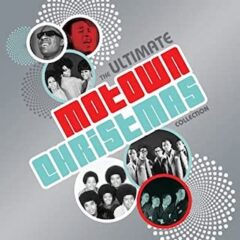 albums from legendary Motown artists such as the Supremes, Smokey Robinson & the Miracles, the Jackson 5, Stevie Wonder, and the Temptations, among others, is because those albums are so good in and of themselves. However, the two-CD, 51-track The Ultimate Motown Christmas Collection is pretty great on its own, too, in that it serves up some of the finest performances from Motown greats along with some worthy installments by good artists who followed the label’s Golden Era. Make no mistake, though—the big names carry this double-disc set, and they alone elevate it to the rank of Yuletide essentials.
albums from legendary Motown artists such as the Supremes, Smokey Robinson & the Miracles, the Jackson 5, Stevie Wonder, and the Temptations, among others, is because those albums are so good in and of themselves. However, the two-CD, 51-track The Ultimate Motown Christmas Collection is pretty great on its own, too, in that it serves up some of the finest performances from Motown greats along with some worthy installments by good artists who followed the label’s Golden Era. Make no mistake, though—the big names carry this double-disc set, and they alone elevate it to the rank of Yuletide essentials.
MARIA MULDAUR, CHRISTMAS AT THE OASIS— Initially available only at her live dates, then offered only on her website, Maria Muldaur’s Christmas the Oasis (recorded in 2010 at San 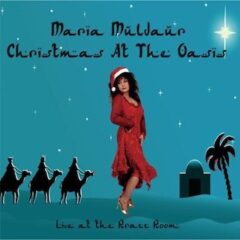 Francisco’s now-defunct Rrazz Room) is now available on Amazon as a manufactured-on-demand CD-R—whatever it takes to get it into wider circulation, because it’s one grand, swinging affair, as rollicking a Yuletide celebration as one could ask, with our gal cutting loose in splendid, attitudinous voice throughout and a powerhouse band kicking it behind her on some vintage holiday fare, including three chestnuts most associated with Louis Armstrong, as well as some evergreens from some of the female blues singers of yore she admires so much.
Francisco’s now-defunct Rrazz Room) is now available on Amazon as a manufactured-on-demand CD-R—whatever it takes to get it into wider circulation, because it’s one grand, swinging affair, as rollicking a Yuletide celebration as one could ask, with our gal cutting loose in splendid, attitudinous voice throughout and a powerhouse band kicking it behind her on some vintage holiday fare, including three chestnuts most associated with Louis Armstrong, as well as some evergreens from some of the female blues singers of yore she admires so much.
MICHAEL MARTIN MURPHEY, ACOUSTIC CHRISTMAS CAROLS: COWBOY CHRISTMAS II—What can you say? At every step Murph makes all 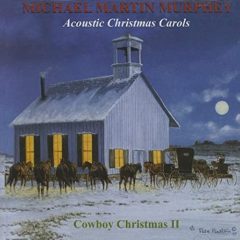 the right moves and delivers a Christmas message in a style all his own, as intimate in its concept and execution as it is expansive in its larger meaning. This is a big-time album, in a quiet way.
the right moves and delivers a Christmas message in a style all his own, as intimate in its concept and execution as it is expansive in its larger meaning. This is a big-time album, in a quiet way.
MARK O’CONNOR, AN APPALACHIAN CHRISTMAS—Comprised largely of superb, previously released performances, An Appalachian Christmas is, says O’Connor, in “the spirit” of the mountain region he sometimes calls home. Purists may indeed agree with an Amazon reviewer who can’t spell Appalachia but decries this as being Appalachian in stock cover photo only; but even taking such objections into account, what’s right here is the spirit invested by some of today’s finest musical artists in lending virtuosity, heart and soul to these proceedings. Merry Christmas to all, and to all a good night.
THEN, NOW, ALWAYS PATTI PAGE—Page’s masterful handling of “Silver Bells” at once evokes the anticipation of Christmas Day and the wonders of the season as piano, bass and a subtle wash of synthesizer offer subtle accompaniment behind her. And that lively combo knocking out “Santa Claus Is Coming To Town” gives the old warhorse of a song an invigorating Vince Guaraldi treatment, as Page does her part with a delightful, sassy vocal. Sweet Sounds of Christmas is everything its title suggests, as well as being an impressive showcase of Patti Page’s distinctive style at its heartfelt best.
THE PERSUASIONS: IN ALL WEATHERS, GLAD TIDINGS—  Given how fundamental the church has been to just about everything the Persuasions have sung in their long career, it’s rather amazing that it took this incomparable a cappella quintet until 1997 to get around to a Christmas album. What’s important, though, is that they did get around to it, because it’s everything you would expect of a Persuasions Christmas album and more, because you never know for certain how the singers are going to find unique ways into their songs. In this case, most of the songs are so familiar as to be daunting, it would seem, to those attempting any variations on the themes. But the Persuasions are just not any group of a cappella practitioners, and so what they do with “Do You Hear What I Hear?” and “Silent Night,” to name a couple of prime examples, is not like anything you’ve heard anyone else do with those songs.
Given how fundamental the church has been to just about everything the Persuasions have sung in their long career, it’s rather amazing that it took this incomparable a cappella quintet until 1997 to get around to a Christmas album. What’s important, though, is that they did get around to it, because it’s everything you would expect of a Persuasions Christmas album and more, because you never know for certain how the singers are going to find unique ways into their songs. In this case, most of the songs are so familiar as to be daunting, it would seem, to those attempting any variations on the themes. But the Persuasions are just not any group of a cappella practitioners, and so what they do with “Do You Hear What I Hear?” and “Silent Night,” to name a couple of prime examples, is not like anything you’ve heard anyone else do with those songs.
ELVIS PRESLEY: The King Keeps Christmas Well—However pleasing the few lush arrangements crafted by producer Felton Jarvis for Elvis on The Wonderful World of Christmas, none were as imaginative or as acutely attuned to Elvis’s vocal stance as were the sophisticated arrangements fashioned for 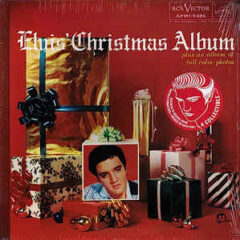 Frank Sinatra by Axel Stordahl, Gordon Jenkins, Nelson Riddle and Don Costa, or for Nat King Cole by Ralph Carmichael , or… Despite Jorgenson’s reports of Elvis’s blasé attitude going into those 1957 and 1971 sessions, however, a listener would be hard pressed to hear anything on the finished products but warm, committed vocalizing on the traditional carols and spirituals and feisty, carefree spirit on the rock ‘n’ roll and blues numbers. Released only a few weeks before Frank Sinatra’s A Jolly Christmas in 1957, Elvis’ Christmas Album was a groundbreaker—the first rock ‘n’ roll Christmas long player, even though most of its second side was filled out by spirituals having no connection to the Yuletide. … Those fans who bought Elvis’ Christmas Album expecting to hear the King of Rock ‘n’ Roll in full flower weren’t disappointed upon cueing up the A side. The Jordanaires open the unassumingly titled “Santa Claus Is Back In Town” by softly humming the word “Christmas” twice, after which Scotty, Bill and D.J. come stomping in, supplemented by a lively Dudley Brooks on piano, setting the stage for Elvis to swagger in, drawling, “Well it’s Christmas time, pretty baby/and the snow is falling down.” Written in the midst of the session in a matter of minutes by Jerry Leiber and Mike Stoller, it was originally titled “Christmas Blues.” The title was changed, but not the double entendre lyrics, which had Santa pulling up in a big black Cadillac. “Hang up your pretty stockings/turn off the light/Santa Claus is coming down your chimney tonight,” Elvis sang in his most suggestive drawl.
Frank Sinatra by Axel Stordahl, Gordon Jenkins, Nelson Riddle and Don Costa, or for Nat King Cole by Ralph Carmichael , or… Despite Jorgenson’s reports of Elvis’s blasé attitude going into those 1957 and 1971 sessions, however, a listener would be hard pressed to hear anything on the finished products but warm, committed vocalizing on the traditional carols and spirituals and feisty, carefree spirit on the rock ‘n’ roll and blues numbers. Released only a few weeks before Frank Sinatra’s A Jolly Christmas in 1957, Elvis’ Christmas Album was a groundbreaker—the first rock ‘n’ roll Christmas long player, even though most of its second side was filled out by spirituals having no connection to the Yuletide. … Those fans who bought Elvis’ Christmas Album expecting to hear the King of Rock ‘n’ Roll in full flower weren’t disappointed upon cueing up the A side. The Jordanaires open the unassumingly titled “Santa Claus Is Back In Town” by softly humming the word “Christmas” twice, after which Scotty, Bill and D.J. come stomping in, supplemented by a lively Dudley Brooks on piano, setting the stage for Elvis to swagger in, drawling, “Well it’s Christmas time, pretty baby/and the snow is falling down.” Written in the midst of the session in a matter of minutes by Jerry Leiber and Mike Stoller, it was originally titled “Christmas Blues.” The title was changed, but not the double entendre lyrics, which had Santa pulling up in a big black Cadillac. “Hang up your pretty stockings/turn off the light/Santa Claus is coming down your chimney tonight,” Elvis sang in his most suggestive drawl.
THE ROYS, Bluegrass Kinda Christmas— The sibling duo of Lee and Elaine Roy closed out 2014 on a high note, with a heralded new studio album, The View, making its debut in September (earning Album of the Week honors at Deep Roots) and later with their first seasonal effort, featuring one new original tune (the title track) amidst a thoughtful collection of country and bluegrass 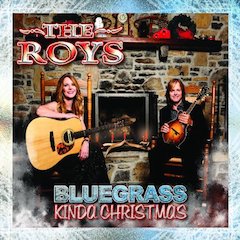 Christmas tunes of mostly recent vintage plus a couple of evergreens. The Roys’ own new tune (“Bluegrass Kinda Christmas,” a co-write with Steve Dean) is a lively seasonal celebration, with Elaine taking a sprightly lead vocal, Lee providing a warm harmony and everyone taking the spotlight for lightning-strike solos that show off the precision and soul of fiddler Clint White, banjo man Daniel Patrick, bassist Erik Alvar and Lee on mandolin. Elsewhere Lee and Elaine put their own stamp on some familiar secular seasonal songs and take time for some stirring reverent moments marking the signal event for Christmas being Christmas.
Christmas tunes of mostly recent vintage plus a couple of evergreens. The Roys’ own new tune (“Bluegrass Kinda Christmas,” a co-write with Steve Dean) is a lively seasonal celebration, with Elaine taking a sprightly lead vocal, Lee providing a warm harmony and everyone taking the spotlight for lightning-strike solos that show off the precision and soul of fiddler Clint White, banjo man Daniel Patrick, bassist Erik Alvar and Lee on mandolin. Elsewhere Lee and Elaine put their own stamp on some familiar secular seasonal songs and take time for some stirring reverent moments marking the signal event for Christmas being Christmas.
‘ZAT YOU, SANTA CLAUS?—  In a worthy followup to his 2002 Yuletide fest,Boogie Woogie Christmas, Brian Setzer and his Orchestra returned in 2005 for a wild-eyed holiday treat via Dig That Crazy Christmas. The whole troupe roars and swings through 11 evergreens, so to speak, and Setzer contributes two new originals: a horn-driven stomper titled “Hey Santa!” spiced with some sizzling vocal and instrumental interplay between Setzer and the orchestra; and a roaring blues grinder in “Santa Drives a Hot Rod,” complete with blaring horns and a fine, growling vocal from Setzer describing the wonders of Santa’s new souped-up wheels now supplanting his a “rusty old sleigh.” Christmas 2009 brought another Setzer Yuletide blast in Ultimate Christmas Collection, a compilation boasting some of the swingin’est tunes from the 2002 and 2005 holiday long players in a collection further sweetened by a DVD, Christmas Extravaganza, featuring no less than 25 songs from a near-two-hour performance. Some of the favorites from the earlier album include the ambitious “Nutcracker Suite,” with its powerhouse horn chart, impressive melding of jazz and classical sensibilities and faithfulness to the moods and spirits of Tchaikovsky’s original composition.
In a worthy followup to his 2002 Yuletide fest,Boogie Woogie Christmas, Brian Setzer and his Orchestra returned in 2005 for a wild-eyed holiday treat via Dig That Crazy Christmas. The whole troupe roars and swings through 11 evergreens, so to speak, and Setzer contributes two new originals: a horn-driven stomper titled “Hey Santa!” spiced with some sizzling vocal and instrumental interplay between Setzer and the orchestra; and a roaring blues grinder in “Santa Drives a Hot Rod,” complete with blaring horns and a fine, growling vocal from Setzer describing the wonders of Santa’s new souped-up wheels now supplanting his a “rusty old sleigh.” Christmas 2009 brought another Setzer Yuletide blast in Ultimate Christmas Collection, a compilation boasting some of the swingin’est tunes from the 2002 and 2005 holiday long players in a collection further sweetened by a DVD, Christmas Extravaganza, featuring no less than 25 songs from a near-two-hour performance. Some of the favorites from the earlier album include the ambitious “Nutcracker Suite,” with its powerhouse horn chart, impressive melding of jazz and classical sensibilities and faithfulness to the moods and spirits of Tchaikovsky’s original composition.
IF IT’S CHRISTMAS, IT MUST BE THE SKAGGS FAMILY, TWICE OVER—Seven years after the release of the first Skaggs Family Christmas album, a tasty collection of a dozen sacred and 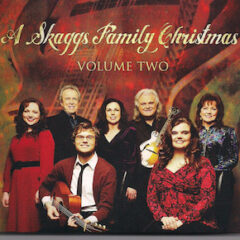 secular carols, the whole clan returned last year with Volume Two of A Skaggs Family Christmas, an impressive triple-gatefold package containing a 10-song CD of studio and live performances plus an accompanying two hour-twenty minute DVD of the entire Skaggs Family Christmas Show, recorded live in Nashville. The performance captured on the DVD is paced with a smart sense of the songs’ dynamics and messages, gives all participants multiple opportunities in the spotlight, and is edited unobtrusively to capture the show’s flow and energy. At 26 songs, it more than doubles the amount of music available on the included CD and would be a bargain, as the saying goes, at twice the price.
secular carols, the whole clan returned last year with Volume Two of A Skaggs Family Christmas, an impressive triple-gatefold package containing a 10-song CD of studio and live performances plus an accompanying two hour-twenty minute DVD of the entire Skaggs Family Christmas Show, recorded live in Nashville. The performance captured on the DVD is paced with a smart sense of the songs’ dynamics and messages, gives all participants multiple opportunities in the spotlight, and is edited unobtrusively to capture the show’s flow and energy. At 26 songs, it more than doubles the amount of music available on the included CD and would be a bargain, as the saying goes, at twice the price.
MINDY SMITH, Snowed In— In 2007 Mindy Smith released one of that year’s finest Christmas albums in My Holiday. Six years later she’s in the spirit again, albeit in EP mode, on this delectable five-song missive titled Snowed In. It’s another seasonal winner for Ms. Smith, whose plaintive voice and sheer conviction is nothing short of captivating
SOLACE AND LAUGHTER IN A VALLEY OF TEARS—Originally released at the end of a tumultuous 1968, Atlantic’s SOUL CHRISTMAS collection, featuring southern soul greats such as 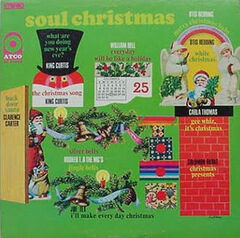 Otis Redding, William Bell, Carla Thomas, Clarence Carter, Booker T. & the MG’s, and others, came along with a message of love, conciliation and reconciliation, delivered with conviction, warmth, inclusiveness and a dollop of humor. It was recorded by black and white musicians in studios in New York and Nashville, but mostly in Memphis, not far from the Lorraine Motel, where the Rev. King lost his life. Soul Christmas abounded in hope without ignoring reality, offered solace and laughter in a valley of tears. It still does; you just have to work a little harder to get there.
Otis Redding, William Bell, Carla Thomas, Clarence Carter, Booker T. & the MG’s, and others, came along with a message of love, conciliation and reconciliation, delivered with conviction, warmth, inclusiveness and a dollop of humor. It was recorded by black and white musicians in studios in New York and Nashville, but mostly in Memphis, not far from the Lorraine Motel, where the Rev. King lost his life. Soul Christmas abounded in hope without ignoring reality, offered solace and laughter in a valley of tears. It still does; you just have to work a little harder to get there.
THE MYTHIC WEIGHT OF PHIL SPECTOR’S CHRISTMAS GIFT by BILLY ALTMAN—Few holiday albums carry the mythic weight of 1963’s A 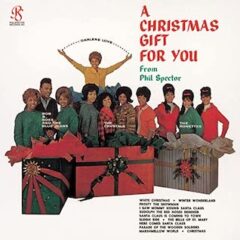 Christmas Gift For You From Phil Spector, wherein Spector sought to put his personal stamp on Christmas music by “treating” a batch of well-worn Yuletide classics to his signature “Wall of Sound” production style. Here’s what happened next, when tragic history intruded on the young producer-titan’s dream project.
Christmas Gift For You From Phil Spector, wherein Spector sought to put his personal stamp on Christmas music by “treating” a batch of well-worn Yuletide classics to his signature “Wall of Sound” production style. Here’s what happened next, when tragic history intruded on the young producer-titan’s dream project.
JO STAFFORD: Season’s Greetings Of A Singular Nature— In recent years most of Jo Stafford’s holiday recordings have been returned to print on two CDs, both beautiful and heartfelt. The 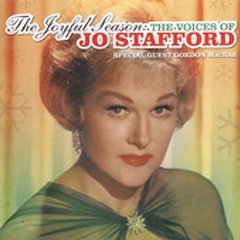 earliest recordings, collected on Happy Holidays: I Love the Winter Weather, are from her 1955 and 1956 albums, Ski Trails and Happy Holidays. The second album in her holiday oeuvre, The Joyful Season: The Voices of Jo Stafford, returns to market her somewhat experimental 1964 long player The Joyful Season, expanded with two excellent bonus tracks and two rich, moving Christmas medleys recorded with Gordon MacRae, both previously unreleased. Suffice it to say, no collection of holiday music can be taken seriously absent Jo Stafford’s contributions.
earliest recordings, collected on Happy Holidays: I Love the Winter Weather, are from her 1955 and 1956 albums, Ski Trails and Happy Holidays. The second album in her holiday oeuvre, The Joyful Season: The Voices of Jo Stafford, returns to market her somewhat experimental 1964 long player The Joyful Season, expanded with two excellent bonus tracks and two rich, moving Christmas medleys recorded with Gordon MacRae, both previously unreleased. Suffice it to say, no collection of holiday music can be taken seriously absent Jo Stafford’s contributions.
CENTURIES OF SENTIMENT AND CELEBRATION By Christopher Hill–STING, If On A Winter’s Night; SUSAN MCKEOWN & LINDSEY HOMER, Through the Bitter Frost and Snow: Every once in a while, an artist happens down the Christmas trail through whose senses we can feel the season freshly; combine that with centuries of festive associations, and you can really have something.
BARBRA STREISAND: CLASSIC CHRISTMAS ALBUM— When it came time to compile a setlist for Barbra Streisand’s Classic Christmas Album entry, producers Didier C. Deutsch, Jeffrey 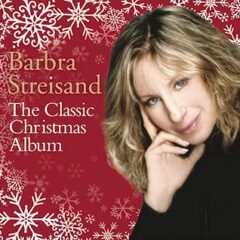 James and Tim Sturges probably couldn’t believe they were getting paid for this task. Babs has but two Christmas albums in her catalog, separated by 34 years’ time, but in their combined 23 tracks the discs offer a bounty that must have made the producer team giddy. This is Streisand at her apex in recordings made almost three-and-a-half decades apart. Make no mistake–she’s the classic here, and a classy one at that.
James and Tim Sturges probably couldn’t believe they were getting paid for this task. Babs has but two Christmas albums in her catalog, separated by 34 years’ time, but in their combined 23 tracks the discs offer a bounty that must have made the producer team giddy. This is Streisand at her apex in recordings made almost three-and-a-half decades apart. Make no mistake–she’s the classic here, and a classy one at that.
CHRISTMAS CARAVAN, Sultans of String (CEN)– Here is the best—and what promises to be the most enduring—Christmas album of the 2017 Yuletide season. Even as Canada’s Sultans of String and their guests put a new spin on traditional favorites, they never get so far out as to render those tunes  unrecognizable. That is, the spirit of the season gets a makeover, but is still the spirit we’ve known for bringing good tidings of great joy. Three-time JUNO nominees in their native Canada, the Sultans of String quintet makes a musical case for inclusiveness and diversity on their first holiday outing, and what impressive support they enlisted. Many of the names here have earned fans beyond the world music audience and all have done exemplary work in their time. We’re talking about the likes of the Chieftains’ great Paddy Moloney; Ruben Blades; Nikki Yanofsky; Sweet Honey in the Rock; Cameroon’s stellar Richard Bona; sitar virtuoso Anwar Kurshid; JUNO award winning country singer Crystal Shawanda, whose string-enhanced, impassioned reading of “Jesous Ahatonhia (Huron Carol)” is a thing of beauty; a recording collective of Turkish Roma violinists from Istanbul adding exotic majesty to “Greensleeves” in a riveting album opener; and the October Project’s Mary Fahl.
unrecognizable. That is, the spirit of the season gets a makeover, but is still the spirit we’ve known for bringing good tidings of great joy. Three-time JUNO nominees in their native Canada, the Sultans of String quintet makes a musical case for inclusiveness and diversity on their first holiday outing, and what impressive support they enlisted. Many of the names here have earned fans beyond the world music audience and all have done exemplary work in their time. We’re talking about the likes of the Chieftains’ great Paddy Moloney; Ruben Blades; Nikki Yanofsky; Sweet Honey in the Rock; Cameroon’s stellar Richard Bona; sitar virtuoso Anwar Kurshid; JUNO award winning country singer Crystal Shawanda, whose string-enhanced, impassioned reading of “Jesous Ahatonhia (Huron Carol)” is a thing of beauty; a recording collective of Turkish Roma violinists from Istanbul adding exotic majesty to “Greensleeves” in a riveting album opener; and the October Project’s Mary Fahl.
THE THREE SUNS, A Ding Dong Dandy Christmas— There was a time, in the late ‘40s into the pre-Elvis early ‘50s, when a trio of guys—who were different guys on record than they were 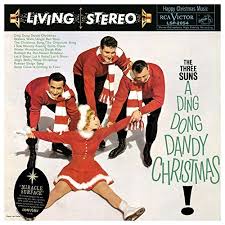 in live performance—playing tasty but fairly straightforward pop instrumentals could command a large enough audience to reach the upper regions of the charts and make a decent living playing clubs. The now-almost-forgotten Three Suns were one such group. … This is the Suns’ fourth Yuletide effort. The first, The Three Suns Present Your Christmas Favorites, was released as a set of three 45 RPM singles in 1949, followed in ’52 by the 10-inch Christmas Party, which in turn was followed, in ’55, by the 12-inch LP Sounds of Christmas. A few of the tunes on the latter Christmas discs were reprised for Ding Dong, but that’s where the similarities end. At this juncture it sounds like the Suns had decided to go for broke and deconstruct these beloved seasonal songs, then put them back together in a way no one had heard them before. If Irving Berlin was so offended by Elvis’s respectful rendering of “White Christmas,” then you have to wonder if he might not have stroked out upon hearing the Suns’ treatment—rapid-fire rock ‘n’ roll guitar glissandos raining down on the track along with rushes of chimes, while a stately organ plays a funereal melody line. If the version of “Skater’s Waltz” included here is the beloved, elegant 1882 classic composition by Émile Waldteufel (who is credited, so it must be), then I’m a suck-egg mule because it’s so far out it’s a different tune—but hilarious in the way the burping tuba keeps getting upstaged by the cartoonish chimes until a Lawrence Welk-ish accordion butts in comically and then gives way to a pretty cool rock ‘n’ roll guitar solo: it sounds like something out of a Marx Brothers movie (save for the guitar).
in live performance—playing tasty but fairly straightforward pop instrumentals could command a large enough audience to reach the upper regions of the charts and make a decent living playing clubs. The now-almost-forgotten Three Suns were one such group. … This is the Suns’ fourth Yuletide effort. The first, The Three Suns Present Your Christmas Favorites, was released as a set of three 45 RPM singles in 1949, followed in ’52 by the 10-inch Christmas Party, which in turn was followed, in ’55, by the 12-inch LP Sounds of Christmas. A few of the tunes on the latter Christmas discs were reprised for Ding Dong, but that’s where the similarities end. At this juncture it sounds like the Suns had decided to go for broke and deconstruct these beloved seasonal songs, then put them back together in a way no one had heard them before. If Irving Berlin was so offended by Elvis’s respectful rendering of “White Christmas,” then you have to wonder if he might not have stroked out upon hearing the Suns’ treatment—rapid-fire rock ‘n’ roll guitar glissandos raining down on the track along with rushes of chimes, while a stately organ plays a funereal melody line. If the version of “Skater’s Waltz” included here is the beloved, elegant 1882 classic composition by Émile Waldteufel (who is credited, so it must be), then I’m a suck-egg mule because it’s so far out it’s a different tune—but hilarious in the way the burping tuba keeps getting upstaged by the cartoonish chimes until a Lawrence Welk-ish accordion butts in comically and then gives way to a pretty cool rock ‘n’ roll guitar solo: it sounds like something out of a Marx Brothers movie (save for the guitar).
DONNA ULISSE, ALL THE WAY TO BETHLEHEM— From the first brisk, fingerpicked acoustic guitar notes on the album opening hosanna, “I See the Light of the World,” to the near-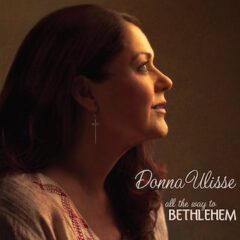 identical melody and spirit summoned by the fiddle, mandolin and pennywhistle on the closing exaltation, “Morning In Bethlehem,” and the vignettes and music that fall in between these bookends, Donna Ulisse’s song cycle All the Way to Bethlehem is not merely close to perfection, it’s a work of art. Employing most of the stellar cast she teamed with on 2009’s Walt This Mountain Down and 2011’s An Easy Climb, both of which easily earned rave reviews in TheBluegrassSpecial.com, Ulisse has crafted a musical novella capturing multiple scenes and points of view relating to the birth of Christ, from the foretelling of his arrival to the trials of Joseph and Mary as they sought a safe place for the child’s birth to the ecstatic celebrations of God’s son arriving in corporeal form. It’s not a Christmas album, in the sense almost every other album reviewed in this issue is a Christmas album; it’s not even a holiday album. It surmounts those limiting categories by humanizing the story’s major players (and in one instance a minor but key figure in the whole scheme of things), by allowing listeners to eavesdrop on their intimate interior monologues—or how Ulisse (who wrote some songs by herself, and others with collaborators familiar to those who have followed her career, namely Marc Rossi and her husband Rick Stanley, son of Ralph) imagines those to have been—during the run-up, if you will, to Christ’s birth. In this sense, All the Way to Bethlehem combines the themes of her previous two albums in delving into matters of faith and its practical application in our daily lives (Walk This Mountain Down) and deeply personal ruminations on faith, love and commitment (An Easy Climb).
identical melody and spirit summoned by the fiddle, mandolin and pennywhistle on the closing exaltation, “Morning In Bethlehem,” and the vignettes and music that fall in between these bookends, Donna Ulisse’s song cycle All the Way to Bethlehem is not merely close to perfection, it’s a work of art. Employing most of the stellar cast she teamed with on 2009’s Walt This Mountain Down and 2011’s An Easy Climb, both of which easily earned rave reviews in TheBluegrassSpecial.com, Ulisse has crafted a musical novella capturing multiple scenes and points of view relating to the birth of Christ, from the foretelling of his arrival to the trials of Joseph and Mary as they sought a safe place for the child’s birth to the ecstatic celebrations of God’s son arriving in corporeal form. It’s not a Christmas album, in the sense almost every other album reviewed in this issue is a Christmas album; it’s not even a holiday album. It surmounts those limiting categories by humanizing the story’s major players (and in one instance a minor but key figure in the whole scheme of things), by allowing listeners to eavesdrop on their intimate interior monologues—or how Ulisse (who wrote some songs by herself, and others with collaborators familiar to those who have followed her career, namely Marc Rossi and her husband Rick Stanley, son of Ralph) imagines those to have been—during the run-up, if you will, to Christ’s birth. In this sense, All the Way to Bethlehem combines the themes of her previous two albums in delving into matters of faith and its practical application in our daily lives (Walk This Mountain Down) and deeply personal ruminations on faith, love and commitment (An Easy Climb).
THE VENTURES, The Ventures’ Christmas Album—Originally released in 1965, The Ventures’ Christmas Album is an essential holiday gem no serious fan of seasonal music can be without. 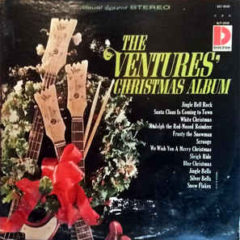 The greatest of all rock ‘n’ roll instrumental groups (having sold more than 100 million records and still playing to enthusiastic audiences the world over), the Ventures were no strangers to the concept album, and they made the most of this one. The particular conceit here is that every song begins with a few bars of a current or recent hit that might otherwise have made it onto another Ventures album or even have already been a hit for the group—such as its career launching 1960 million seller “Walk, Don’t Run,” which opens this album before slyly transitioning into “Sleigh Ride” as Edwards ratchets up the reverb and deploys his wang bar periodically for effect. The bluesy start of Johnny Rivers’s version of “Memphis” is but prelude for a stomping rendition of “Jingle Bell Rock.” The trebly opening licks of the Beatles’ “I Feel Fine” make for an exciting intro to… “Rudolph the Red-Nosed Reindeer.” Get it? Then get it!
The greatest of all rock ‘n’ roll instrumental groups (having sold more than 100 million records and still playing to enthusiastic audiences the world over), the Ventures were no strangers to the concept album, and they made the most of this one. The particular conceit here is that every song begins with a few bars of a current or recent hit that might otherwise have made it onto another Ventures album or even have already been a hit for the group—such as its career launching 1960 million seller “Walk, Don’t Run,” which opens this album before slyly transitioning into “Sleigh Ride” as Edwards ratchets up the reverb and deploys his wang bar periodically for effect. The bluesy start of Johnny Rivers’s version of “Memphis” is but prelude for a stomping rendition of “Jingle Bell Rock.” The trebly opening licks of the Beatles’ “I Feel Fine” make for an exciting intro to… “Rudolph the Red-Nosed Reindeer.” Get it? Then get it!
RHONDA VINCENT, CHRISTMAS TIME— It was 2006 when last we heard from Rhonda Vincent at Christmas time, but come 2015 she returned in style 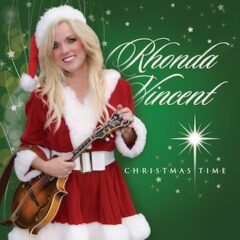 with, yes, Christmas Time, featuring a delightful dozen tunes including four Vincent originals (one of which, “Christmas Time at Home,” was re-recorded for this project after appearing first on the 2006 album, Beautiful Star: The Christmas Collection). Her stellar band, The Rage, is supplemented by the likes of Stuart Duncan on fiddle, the increasingly visible Sierra Hull on mandolin, Michael Rojas on piano and Mike Johnson on steel, all of whom make this a holly, jolly Yuletide evergreen of a seasonal album.
with, yes, Christmas Time, featuring a delightful dozen tunes including four Vincent originals (one of which, “Christmas Time at Home,” was re-recorded for this project after appearing first on the 2006 album, Beautiful Star: The Christmas Collection). Her stellar band, The Rage, is supplemented by the likes of Stuart Duncan on fiddle, the increasingly visible Sierra Hull on mandolin, Michael Rojas on piano and Mike Johnson on steel, all of whom make this a holly, jolly Yuletide evergreen of a seasonal album.
ANDY WILLIAMS: CLASSIC CHRISTMAS ALBUM—Let it be said that the late Andy Williams knew how to keep Christmas well. The man recorded no less than eight Yule albums, three of which provide the bulk of the material for this Classic Christmas Album release. Given that most of the tracks fall in that period when Williams was not only hot on the charts but also hosting his own wildly popular TV variety show, he’s in peak vocal form here. It’s a most wonderful time, this album.
WINTERBLOOM, TRADITIONS REARRANGED—It’s unclear at this point exactly how down with Father Christmas the four impressive gals of Winterbloom really are, but they sure have made their holiday EP a memorable event, acerbic and reverent all at once.
DAVID WOOD, A CHRISTMAS GIFT –It’s a spare, haunting, reverent but spiritually enriching, often joyous album, featuring only Mr. Wood and his rich acoustic guitar on 22 songs (you 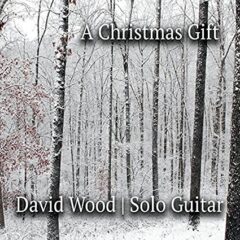 don’t get cheated here), three of which are the artist’s own originals (plus a 32-second prelude and 31-second postlude referencing the sacred carol “O Come, O Come, Emmanuel.” Note the postlude and prelude, though: the former establishes the theme for what’s to come, the other brings the journey full circle. The journey is into the heart of the Christmas experience, not the commercial one (which makes the inclusion of Vince Guaraldi’s delightful “Christmas Time is Here” amusing indeed, as a tuneful, gentle reminder of what Christmas is all about, Charlie Brown). … Much like John Fahey’s more metaphysical The New Possibility, A Christmas Gift is, without qualification, a work of art, a great album for any season and for anyone willing to open his or her heart to that which makes us whole.
don’t get cheated here), three of which are the artist’s own originals (plus a 32-second prelude and 31-second postlude referencing the sacred carol “O Come, O Come, Emmanuel.” Note the postlude and prelude, though: the former establishes the theme for what’s to come, the other brings the journey full circle. The journey is into the heart of the Christmas experience, not the commercial one (which makes the inclusion of Vince Guaraldi’s delightful “Christmas Time is Here” amusing indeed, as a tuneful, gentle reminder of what Christmas is all about, Charlie Brown). … Much like John Fahey’s more metaphysical The New Possibility, A Christmas Gift is, without qualification, a work of art, a great album for any season and for anyone willing to open his or her heart to that which makes us whole.
TRISHA YEARWOOD, THE SWEETEST GIFT— For her first holiday album, one of country’s great singers eschewed the safety of seasonal favorites for a 50-50 mix, with half of the songs being newly penned by contemporary songwriters. Despite being no stranger to huge, soaring ballads, Yearwood here opts mostly for a low-key approach, and by and large keeps it country; in the end the sweetest gift is quietude. That said, one of the most engaging numbers on the album is in fact one of the grander productions, “Take a Walk Through Bethlehem,” by Ashley Cleveland, John Barlow Jarvis and Wally Wilson. To advance its message of faith and hope as the road to salvation, Yearwood’s long-time producer Garth Fundis employs a string section, multi-voiced background choir (which includes songwriter Ashley Cleveland), a church piano courtesy Steve Nathan and the occasional jab of Brent Mason’s electric guitar, but these don’t appear in abundance until the song nears its end, when Yearwood gives free reign to her big voice and the collective surges to a triumphant close.
GATHERING EVERGREENS
(from our archives, other recommended recent and vintage Christmas music)
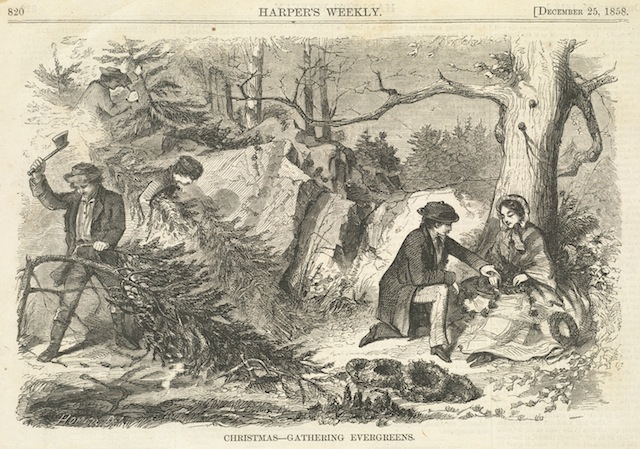
THE EDIE ADAMS CHRISTMAS ALBUM with ERNIE KOVACS
DEANA CARTER, Father Christmas
CHERISH THE LADIES, A Star in the East
A CHRISTMAS CELTIC SOJOURN LIVE
CHARLIE DANIELS, A Merry Christmas To All
NNENNA FREELON & THE JOHN BROWN BIG BAND, Christmas
DAVID IAN, Vintage Christmas Wonderland
ETTA JAMES, 12 Songs of Christmas
GLADYS KNIGHT & THE PIPS: CLASSIC CHRISTMAS ALBUM
HEY ROSETTA, A Cup of Kindness
TOBY KEITH, A Classic Christmas, Vols. One and Two
PATTY LOVELESS, Bluegrass & White Snow
MARTINA MCBRIDE: CLASSIC CHRISTMAS ALBUM
DEAN MARTIN, Christmas With Dino
KATHY MATTEA, Joy For Christmas Day
REBA MCENTIRE, The Best Of Reba: The Christmas Collection
NEW GRANGE, Christmas Heritage
JOE NICHOLS, A Traditional Christmas
BRAD PAISLEY, A Brad Paisley Christmas
PAM TILLIS, Just In Time For Christmas
THE JAY UNGAR & MOLLY MASON FAMILY BAND, A Fiddler’s Holiday
CHRISTMAS COOKIES (Various Artists)
O CHRISTMAS TREE: A BLUEGRASS COLLECTION FOR THE HOLIDAYS (Various Artists)
SHIMMY DOWN THE CHIMNEY: A COUNTRY CHRISTMAS (Various Artists)
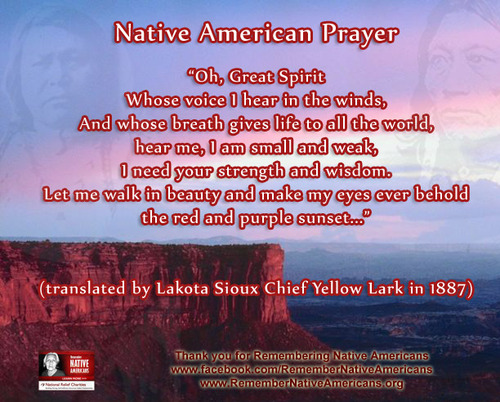


A Christmas Carol is a 1910 silent drama film directed by J. Searle Dawley and produced at Edison Studios in The Bronx in New York City. After the 1901 British release Scrooge, or, Marley’s Ghost, this American version of Charles Dickens’ 1843 novella is the second oldest surviving screen adaptation of the famous literary work. It features Marc McDermott as Ebenezer Scrooge and Charles S. Ogle as Bob Cratchit. Source: Wikipedia
***
As So As Tiny Tim Observed…
Scrooge Transformed: The final scenes from the 1984 production of A Christmas Carol

![The Deep Roots Yuletide Baedeker 2021 122 A Christmas Carol [1984] Final Scene](https://i.ytimg.com/vi/b7Um603B2lI/hqdefault.jpg)

The closing song, ‘God Bless Us Every One,’ written by Tony and Nick Bicât for the 1984 production of A Christmas Carol and heard in full over the closing credits. Posted at YouTube by Daughter of Ramandu.




